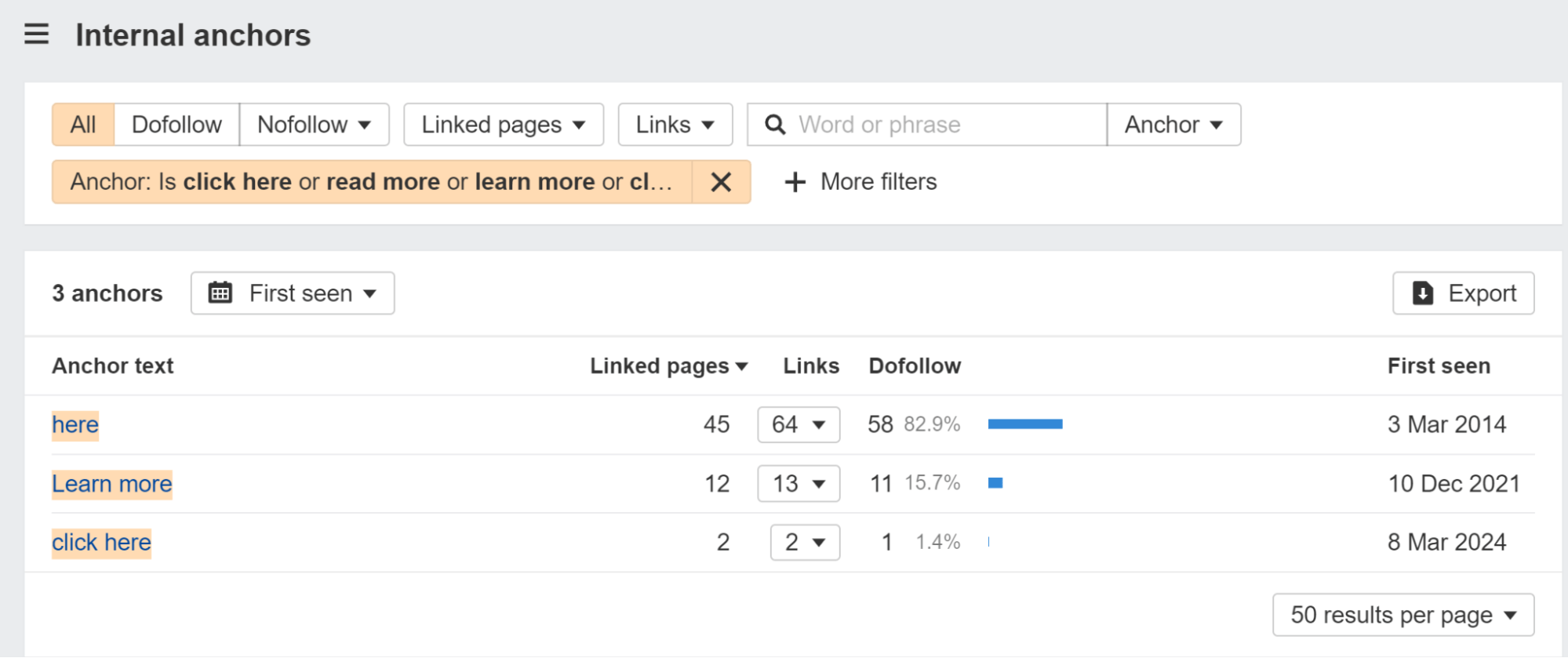Some popular enterprise SEO tools include:
| Product | Reviews | Pricing | Customers |
|---|---|---|---|
| Ahrefs | Starts at $14,990 / year | 50,000+ | |
| Conductor |
| No public pricing | 450+ |
| seoClarity | 3,500+ | ||
| Botify |
| No public pricing | 500+ |
| BrightEdge | No public pricing | 1,700+ |
With so many different tools and so many different needs, how do you know what’s right for you?
I’m obviously biased towards Ahrefs, but we’re really in a league of our own with 44% of the S&P 500 choosing us. Look how we compare to other enterprise SEO tools in the market.
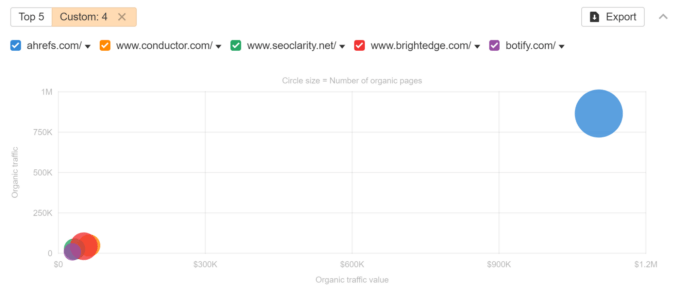
And our organic search share of voice (SoV).
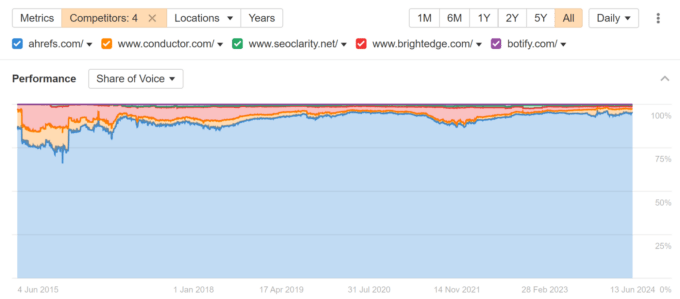

This is obviously our top pick, but it deserves to be. Don’t just take our word for it. Ask around and see who comes up as the platform of choice for SEOs. See who real users favor.
How Ahrefs describes themselves:
Ahrefs is an all-in-one SEO toolset for growing search traffic and optimizing websites.
We crawl the entire web, collect and process petabytes of data every day, then give this information context and make it accessible via a simple user interface.
Our crawler processes up to 8 billion pages a day, and we update our index with the freshest backlinks on the web every few minutes.
I’m biased because I work here, but I work here because I’m a fan and I strongly believe in the product, the data, and the company.
Unique selling proposition of Ahrefs: Data. We have more of it than anyone else, over 715 PBs of data.
Ahrefs features:
- Keyword research
- Backlink analysis
- Rank tracking
- Link building
- Competitor analysis
- Site audits
- SEO alerting
- SEO change tracking
- and many more.
Pros of Ahrefs according to Reddit users:
- Comprehensive SEO Tools: Ahrefs is known for its wide range of SEO tools, including keyword research, backlink analysis, site auditing, and more, making it a one-stop solution for many SEO needs.
- Accurate Data: Users have praised Ahrefs for its accurate and up-to-date data, particularly in terms of backlinks and keyword rankings.
- Competitor Analysis: Ahrefs offers robust competitor analysis tools, allowing users to gain insights into their competitors’ strategies and performance.
- User-Friendly Interface: Many users find Ahrefs’ interface intuitive and user-friendly, which can be particularly helpful for those new to SEO.
- Regular Updates and Improvements: Ahrefs is known for continuous updates and improvements to its tools and features, staying relevant in the ever-evolving field of SEO.
- Customer Support: Users have reported positive experiences with Ahrefs’ customer support, noting quick response times and helpful assistance.
Cons of Ahrefs according to Reddit users:
- Limited Local SEO Data: Ahrefs’ local SEO capabilities, while present, may not be as robust as some other specialized local SEO tools.
- No phone support: Ahrefs does not offer phone support.
Ahrefs has over 50,000 subscribers including many of the world’s top enterprise companies like:
- Adobe
- eBay
- IBM
- Zoom
- Johnson & Johnson
- Dell
- Capital One
- Accenture
- Tripadvisor
- Hubspot
- SurveyMonkey
- Shopify
- Expedia
Be sure to watch our how to use Ahrefs videos!
We’re the favorite tool for enterprise SEO teams. We epitomize big data.
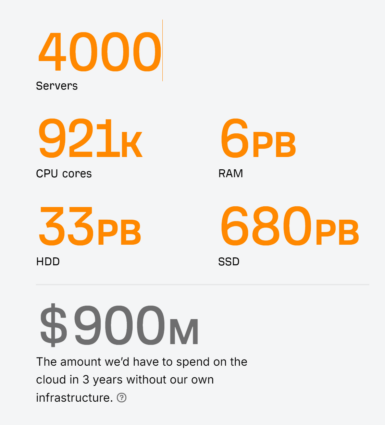
For some context, Google’s index is around 100 PB. We store over 7x that amount.
You’ll see these differences between us and competitors in the platform itself. We’re extremely fast and have granular data that no one else has.
We also have the 34th fastest supercomputer in the world! This lets us do more with machine learning and AI than most companies on the planet.

We crawl faster than any other SEO tool, according to Cloudflare Radar.
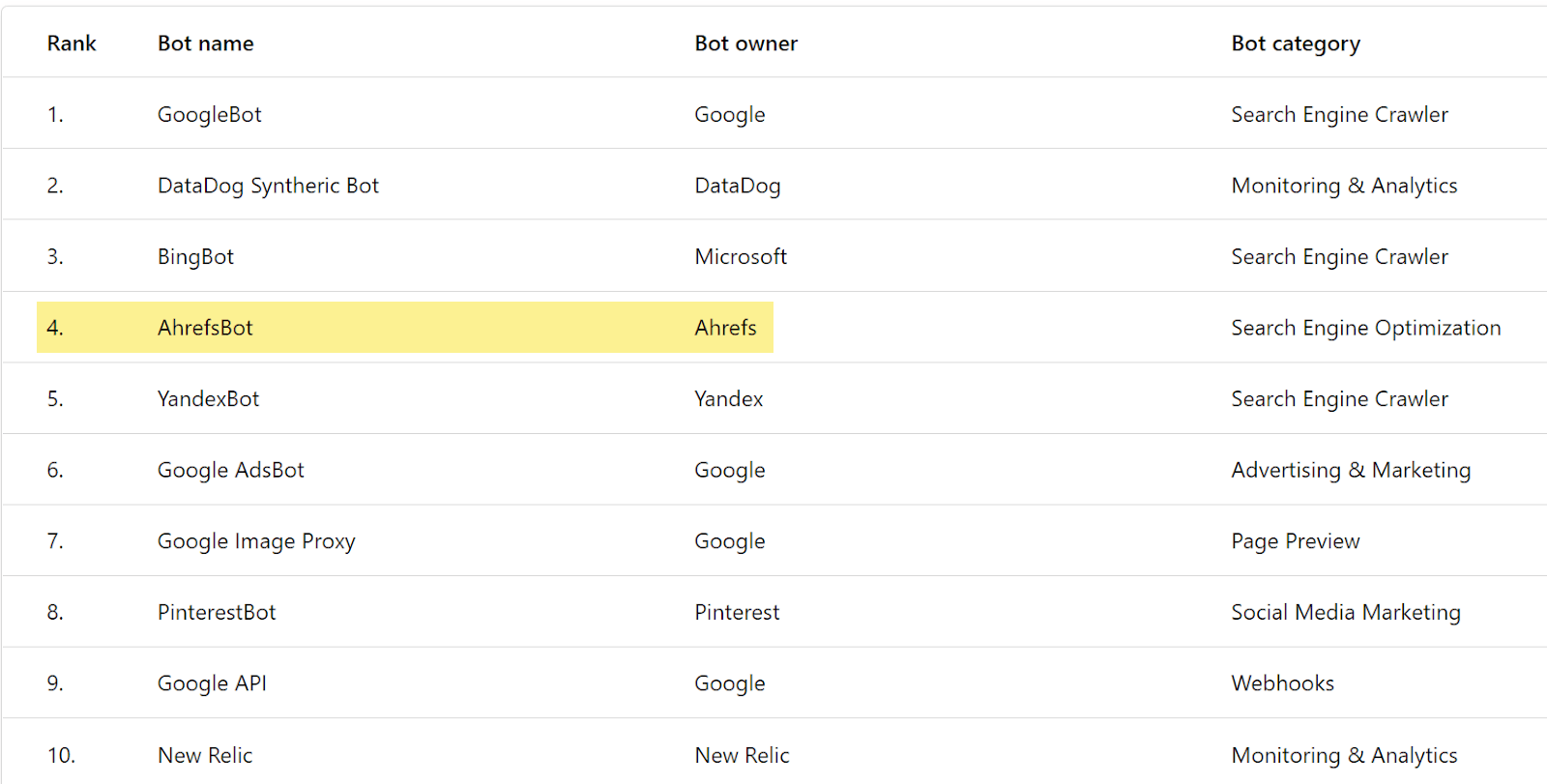
We’re the best backlink checker, according to Matthew Woodward’s test of 1 million domains. We’re the only SEO tool that will pick up links added with JavaScript for our backlink index because we’re the only one that renders pages while crawling the web.
On top of that, we’re the only SEO platform that is fed data from IndexNow which is a data submission partnership used by search engines. 60 million sites are feeding us 2.5 billion new and updated pages per day.
For links and pages, that means we have the largest and freshest data.
We have the largest keyword database with 74B keywords that we filter to remove noise, because we also care about the quality of data shown to users.
We have the most accurate traffic estimates, according to Authority Hacker. For keywords where we have enough data, we use individually model click-through rate (CTR) curves rather than using a single generic model for the curves.
We’re constantly adding to the product. We made 130+ product updates in 2023. You can find many of our upcoming product updates on our pricing page, including an always-on version of Site Audit, some forecasting options, the ability to import historical data for keywords in Rank Tracker, a cutting edge content tool, some more reporting capabilities, and a system called Patches that will solve SEO issues at scale.
There are also our industry-leading articles, videos, and courses. These resources will educate you on SEO and show you how to make the best use of the platform.
We have a lot of features that enterprise SEOs love.
Opportunities reports
Knowing what to prioritize is the hardest part of SEO. We created the Opportunities report to help SEOs work on things that will move the needle. If you’re not sure where to start, look at these reports and measure progress towards the opportunities shown and you will likely show a lot of success to your stakeholders. This report is a great starting point for an enterprise SEO audit.

You could also work with the in-house team or the dev team if you are in-house to create a visualization of what you consider the most important and impactful SEO projects. I normally use an impact / effort matrix for this to show how hard projects are and their estimated impact. Based on their coordinates, it’s easy to see which projects you should prioritize.
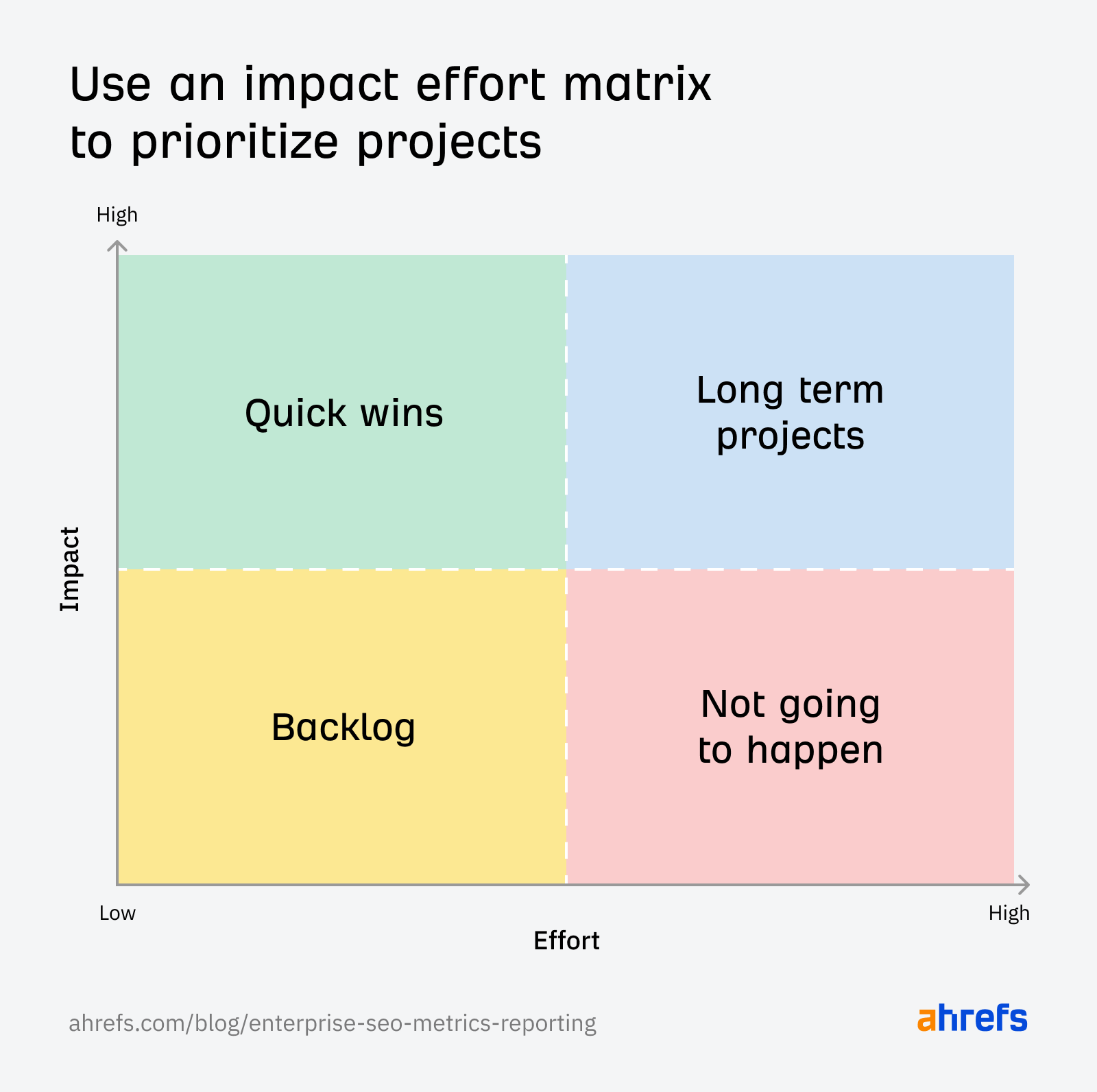
Market views
For a high-level overview of the competitor landscape that is visually appealing, check out the Organic Competitors report in Ahrefs’ Site Explorer. This shows you three different metrics at a glance including Organic Traffic Value, Organic Traffic, and the number of pages on the site. You can also use a list of custom sites for the visualization if there are certain competitors you want to show.
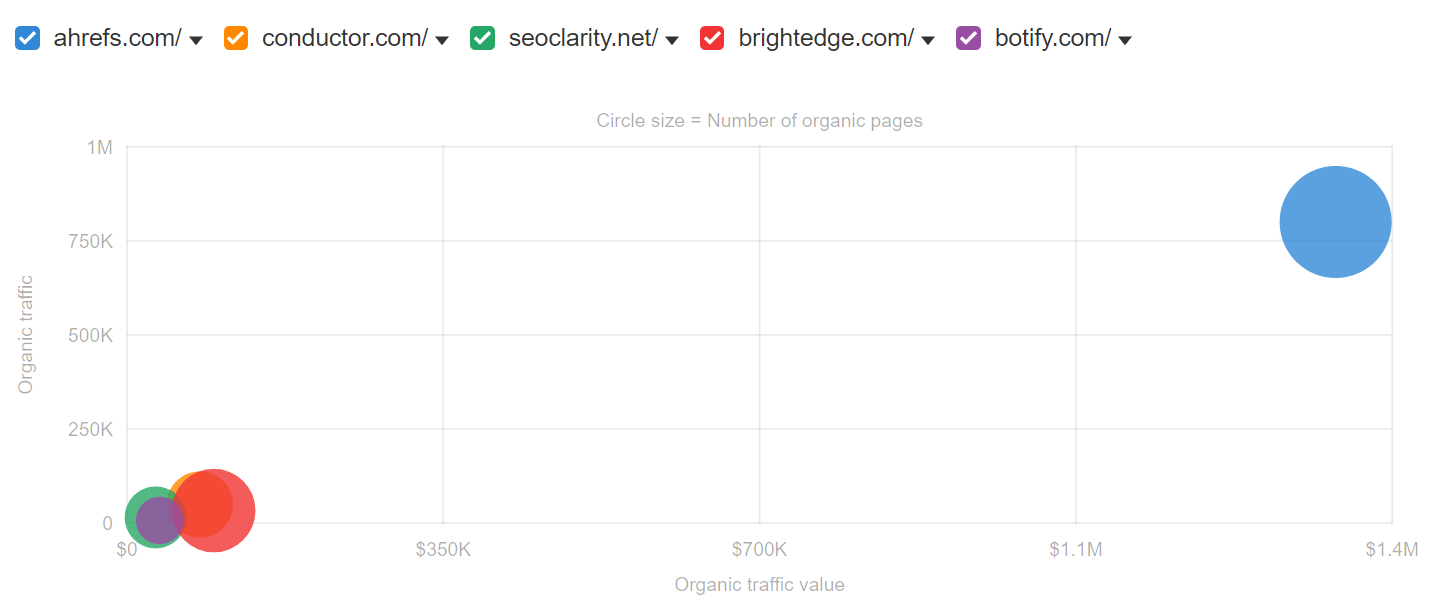
You can add a date comparison such as this year vs. last year to show how the market has evolved over a period of time.
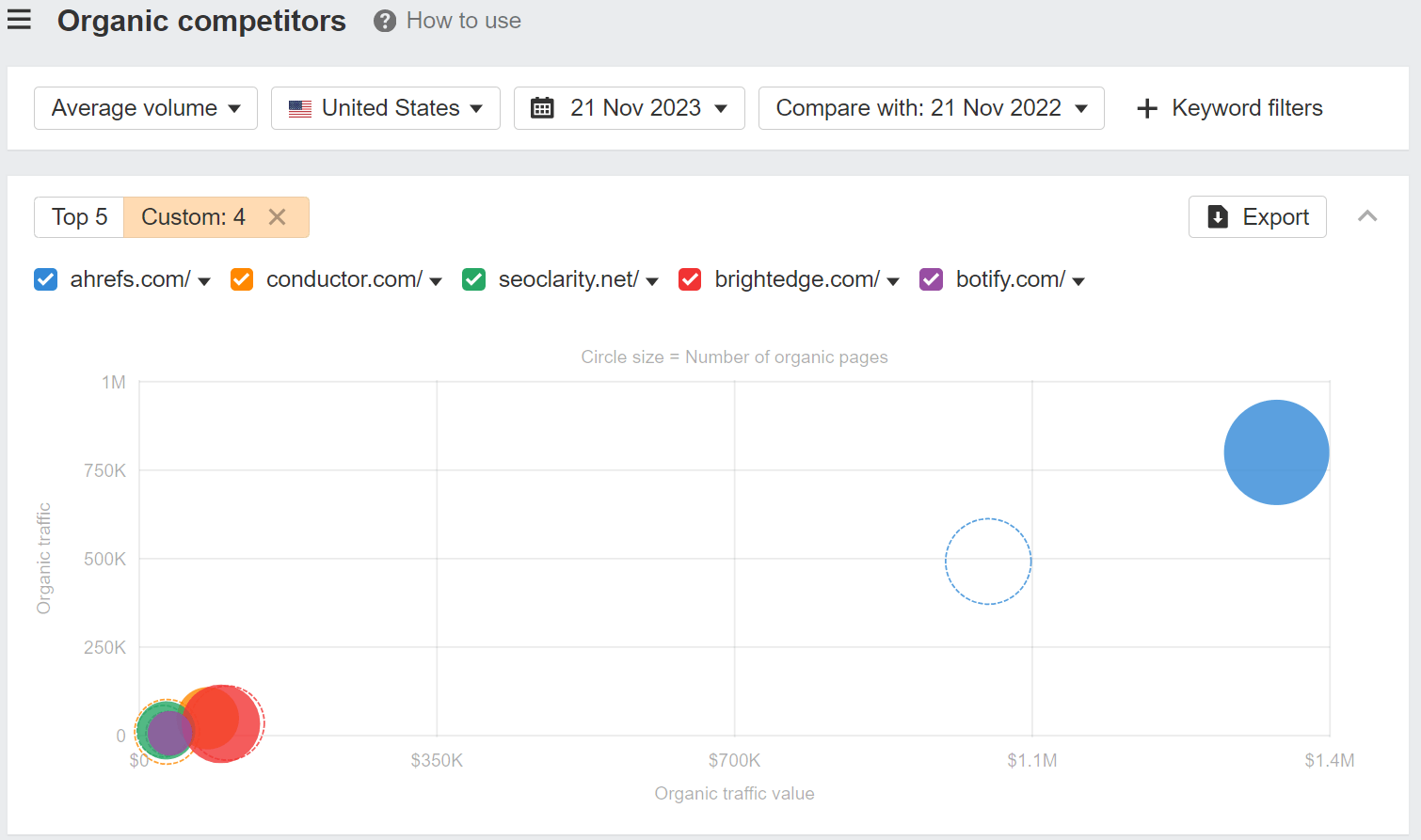
The report will also work with more than just domains. You can plug in a specific website path or page if you’re reporting to a particular group or product team and need a more narrow view.
We also have charts for Share of Voice (SoV) & Share of Traffic Value (SoTV). SoTV is unique to Ahrefs. It’s more of a money metric, tied to the paid search cost of organic traffic.

Portfolios
Now, you can group a list of up to 1000 URLs from up to 10 unique domains and track them as a single project to see their aggregated metrics in Site Explorer.
If you want to segment a site, or track multiple sites and research as if they were one, you can.
You can use it to:
- Track your top competitors as a single entity to gain insight into how your industry is doing as a whole in terms of search traffic, how it’s coping with major Google algorithm updates, how it compares to other industries, and so on.
- Combine multiple “regional” domains to track their performance as a single entity.
- Create author-specific portfolios if you have multiple authors publishing content on your website. This lets you see which authors are bringing the most search traffic and backlinks, which ones have a higher publishing pace, and so on.
- Set up client portfolios to create focused reports showing how your portfolio of content on their website has been performing.
- Create sets of pages for testing on-page SEO tactics. Just set up a portfolio of the pages you’re implementing these tactics on, and track it against a second portfolio of pages in your control group.
- Do rank tracking on steroids – no need to manually track hundreds of keywords per page when you can create a portfolio of pages, and be shown the thousands of keywords that they rank for.
Enterprise SEO scorecards
SEO scorecards let you monitor performance and compare one group to another or one section of a site to another.
Our Site Structure report in Site Explorer has a lot of the information you’d use to create this scorecard view. You can even compare between two dates.
The columns are customizable so you can show only the metrics you need. We have Referring Pages, Referring Domains, Organic Traffic, Traffic Value, Organic Keywords, and Organic Pages available.
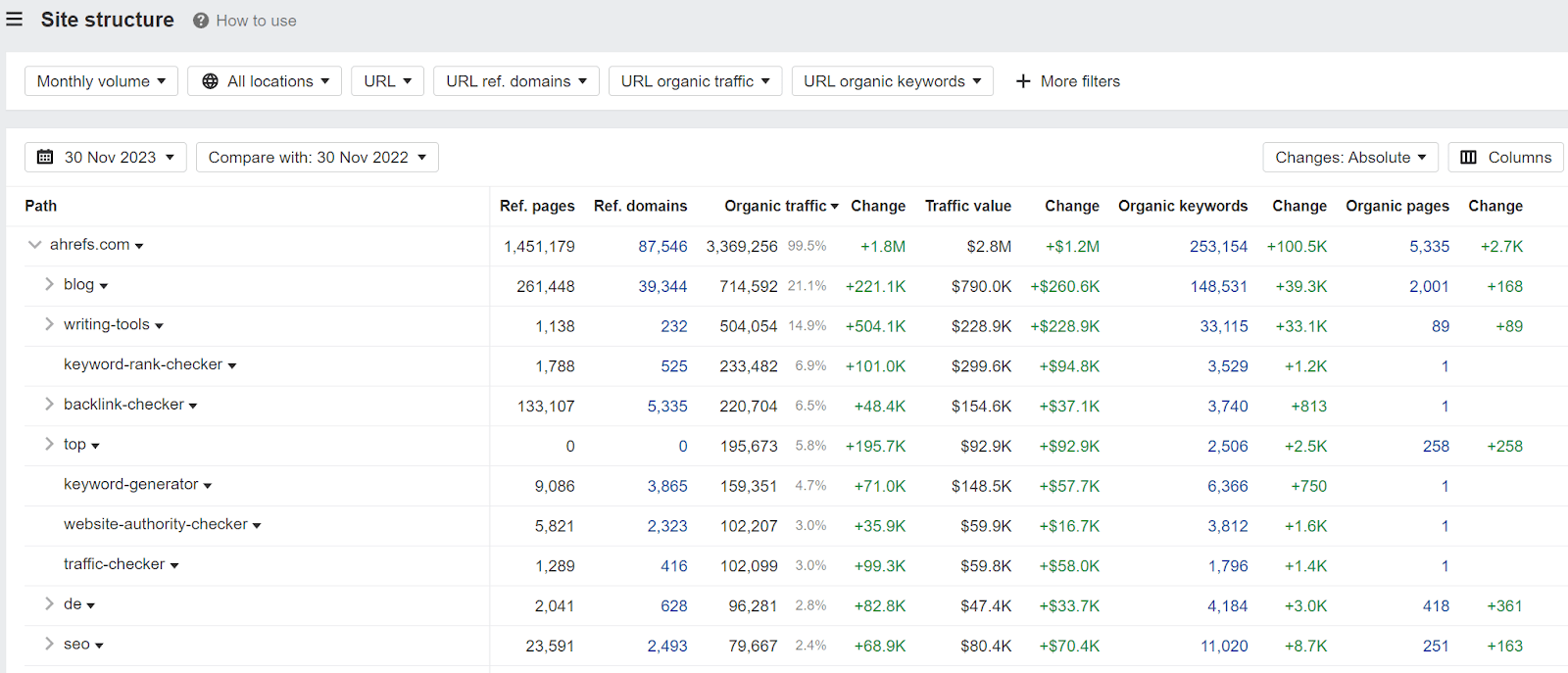
You can pull technical issues from Site Audit where you might want to show health scores over time for different sections of the site, Core Web Vitals, or general errors. In the past, I’ve created views that showed the number of pages we still need to redirect, Core Web Vitals scoring, and pages that have too many redirect hops.
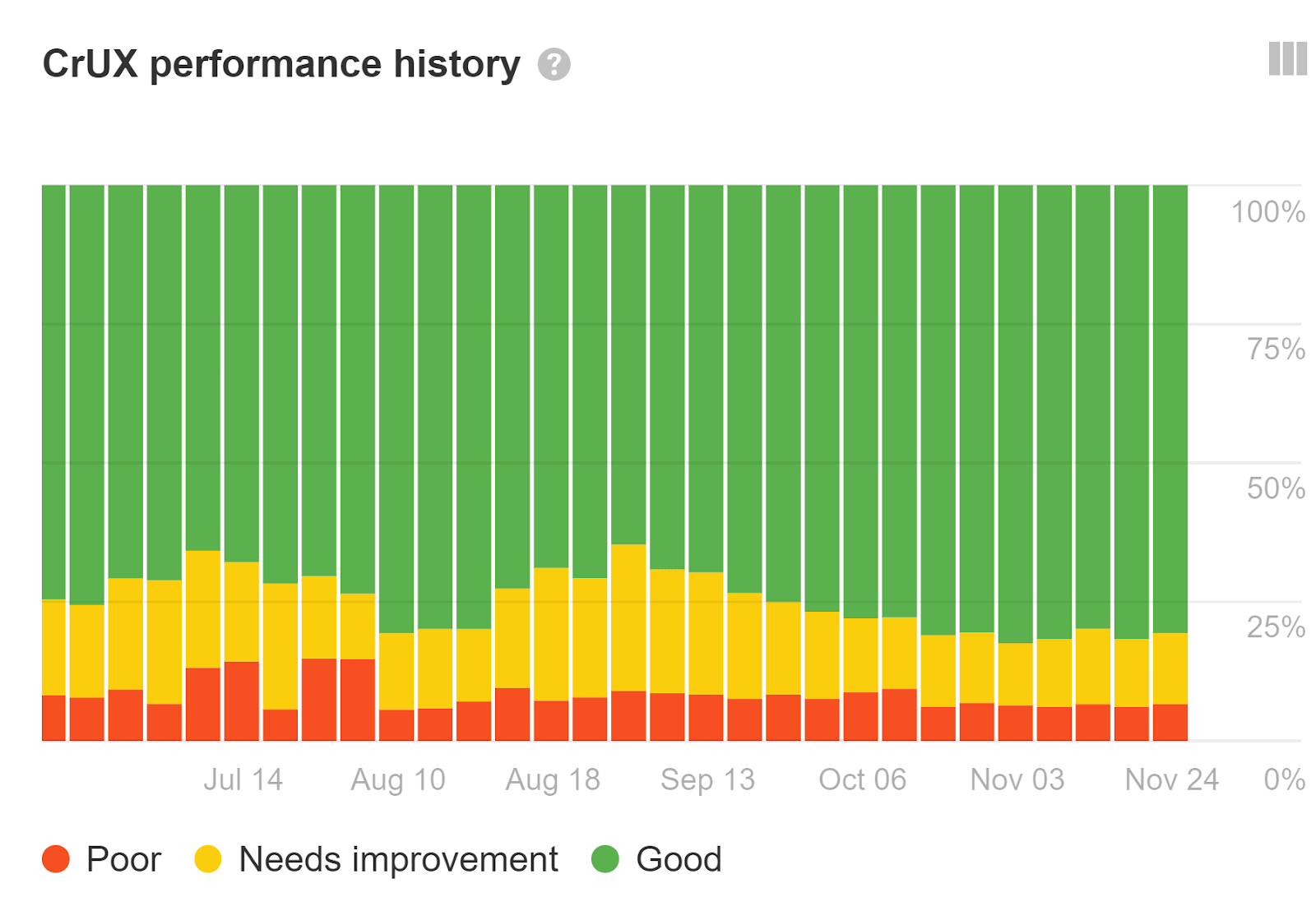
You can also create custom groupings of pages using our Portfolios feature. If you have a business unit or product offering that owns some pages on the blog, some pages in the product section, some pages in support, etc., then you can add them as a Portfolio to get a rolled up view. Portfolios support up to 10 different domains and 1,000 different pages or paths.
Your GSC data, but better
With the GSC Overview report, your team can analyze your Google Search Console property and see the distribution of clicks, impressions, and CTR by position right in Rank Tracker. We store the full history, from the time you connect the data.
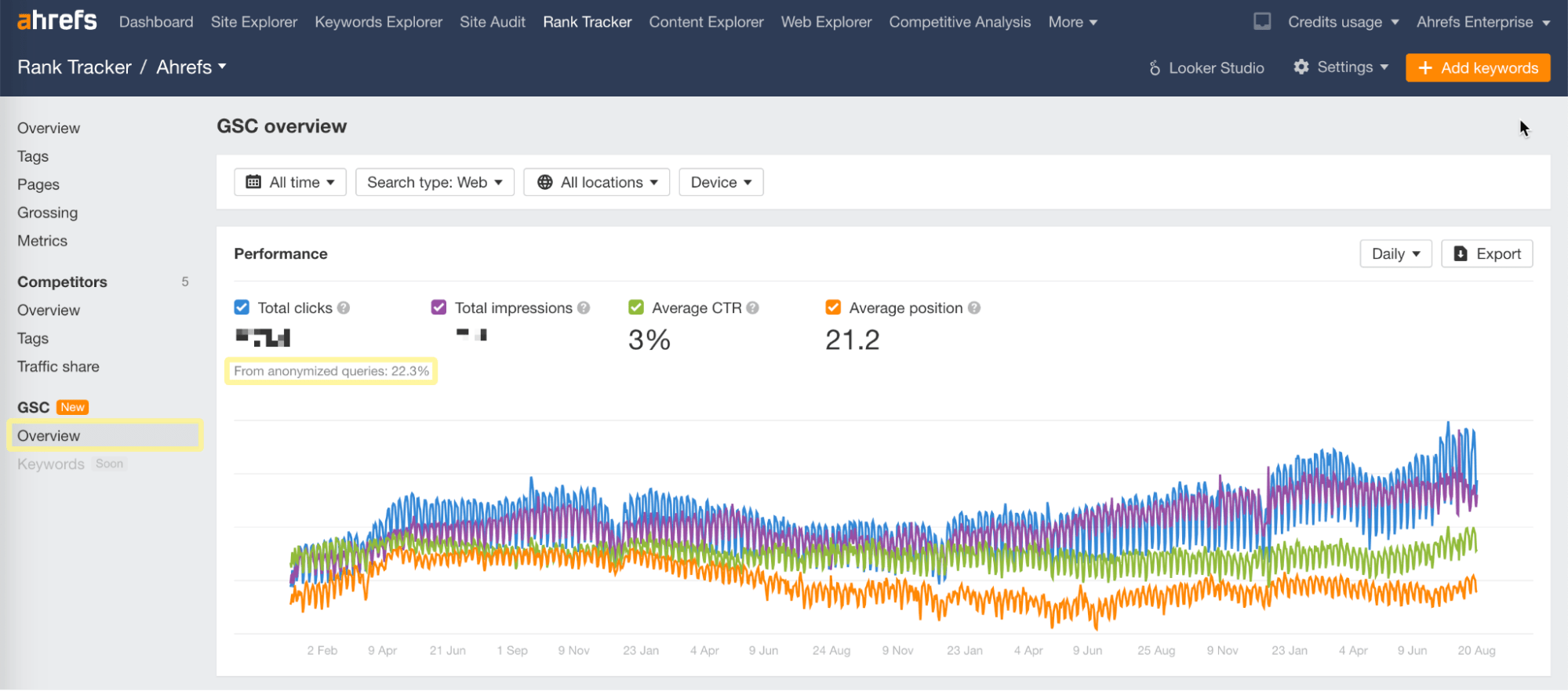
If you’re doing opportunity forecasting to sell content creation initiatives, you’ll find our custom CTR curve models handy. They’re based on your own Google Search Console (GSC) data.
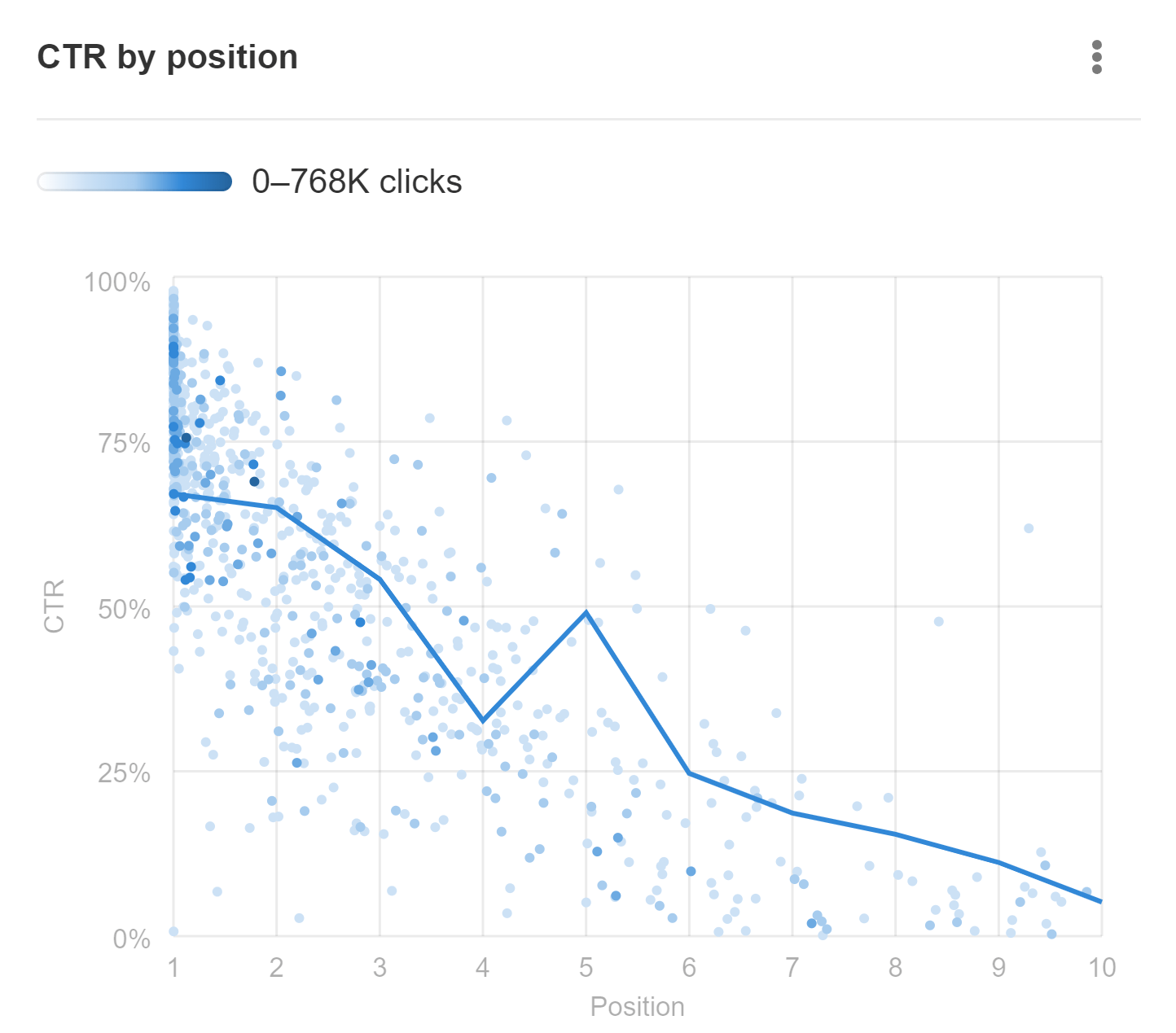
We also have
- Top keywords
- Top keyword changes
- Low hanging fruit keywords, which shows you the most popular keywords where your target’s ranking position is between 4 and 15
- Potential cannibalization, which shows you keywords with multiple ranking URLs
- Top pages
- Top page changes

Content opportunities
You can use the Content Gap tool to find these opportunities, but you may see some repeated opportunities because of similar keywords. We will update this to add clustering and help reduce this extra noise.
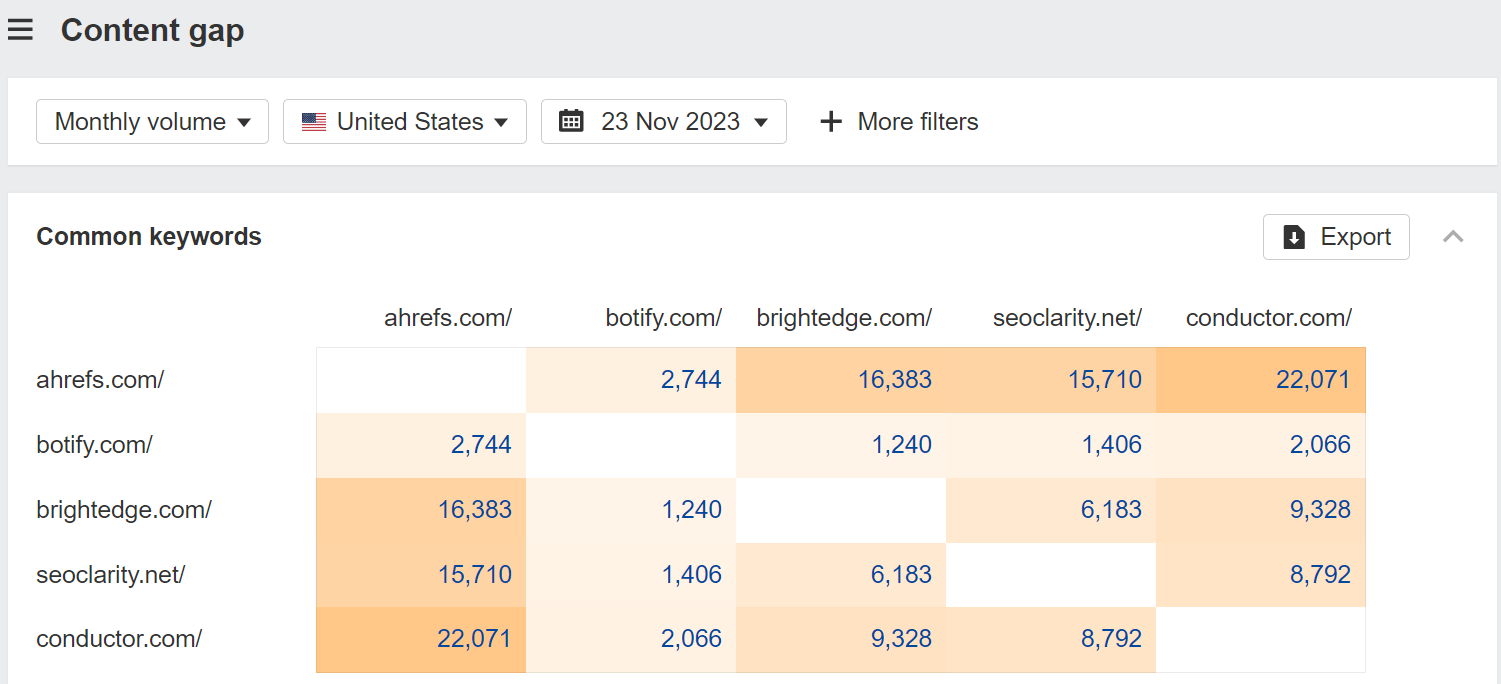
For now, you may want to export the keywords from the Content Gap tool and paste them into Keywords Explorer. Then go to the “Clusters by Parent Topic” tab. This should give you actual content opportunities you may not be covering.
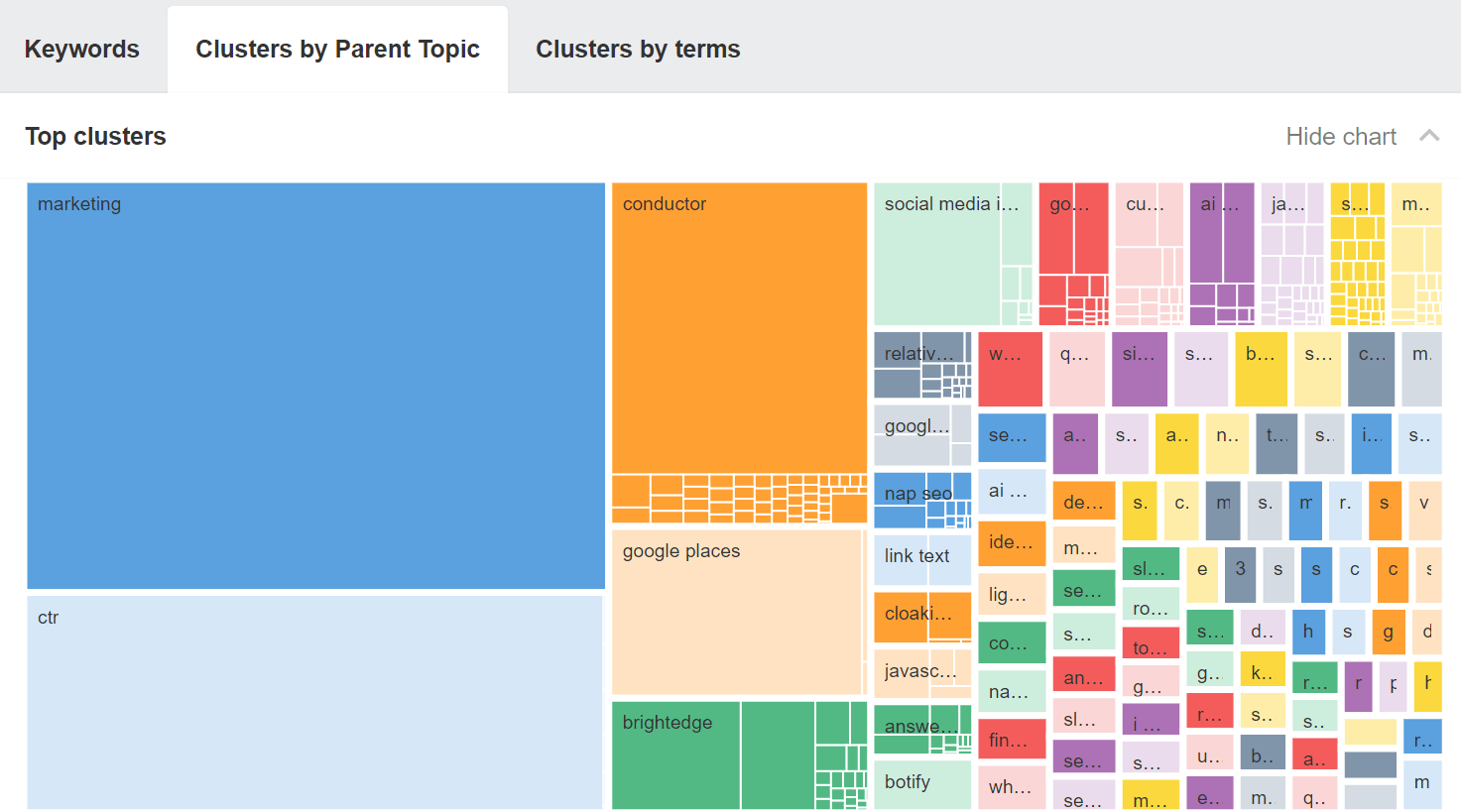
You can take these opportunities and the total volume of the clusters to use in your forecasts to come up with more accurate forecasts than those that use just one term per page. You could also just look at our Traffic Potential (TP) metric to get an idea of how much traffic a page might get.
AI Content Grader tool
Just enter your URL and its target keyword, and Content Grader will:
- Take the top 3 articles ranking for that keyword and identify the core topics covered in those articles
- Analyze how well your article and the top articles cover each topic
- Identify the topics that your article has lower scores for
- Show suggestions on how to improve your content to get better results
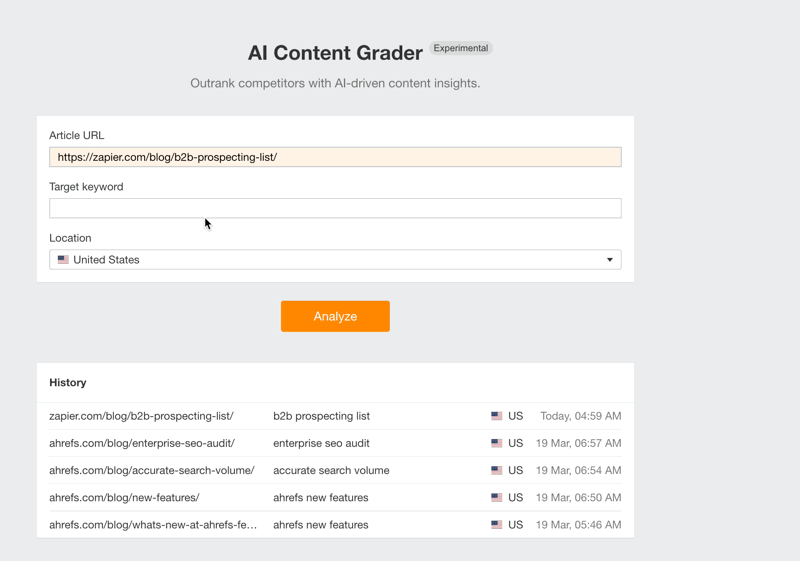
Find internal link opportunities
Our Internal link opportunities report identifies internal link opportunities by taking the top 10 keywords for your ranking pages—then finding mentions of them on your other pages.
Including important keyword metrics and the keyword context. How cool is that?

We won’t suggest a link if one already exists between the pages.
Despite this, you can still find the pages mentioning your terms by going to the Page explorer report and searching for the keyword within the HTML feature.
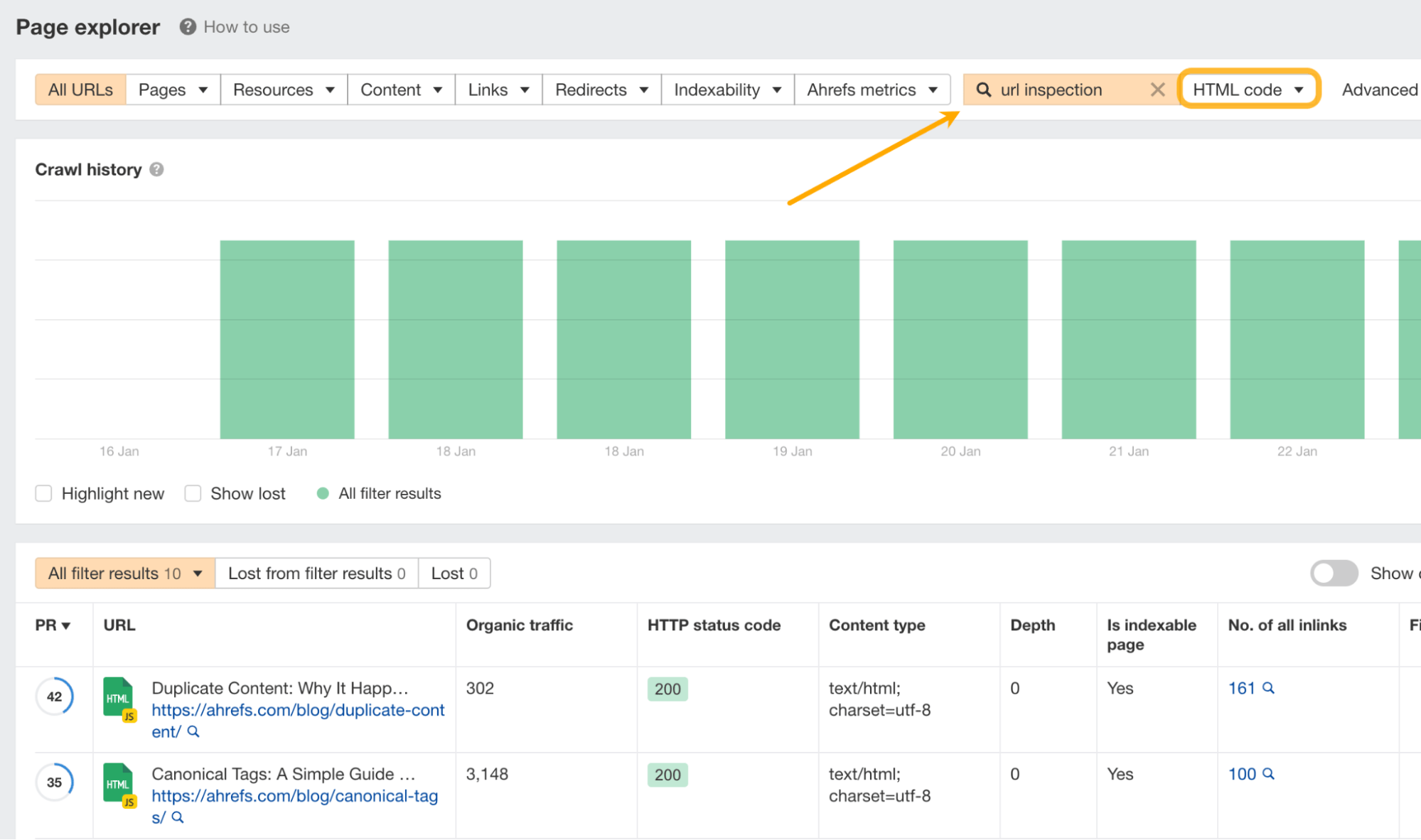
Search intent
You can use the “Identify intents” feature in Keywords Explorer to show the main intent of each term and the percentage of traffic to each intent. This helps you identify content angles or ways you can position your content to maximize traffic or if you’re even targeting the right things.
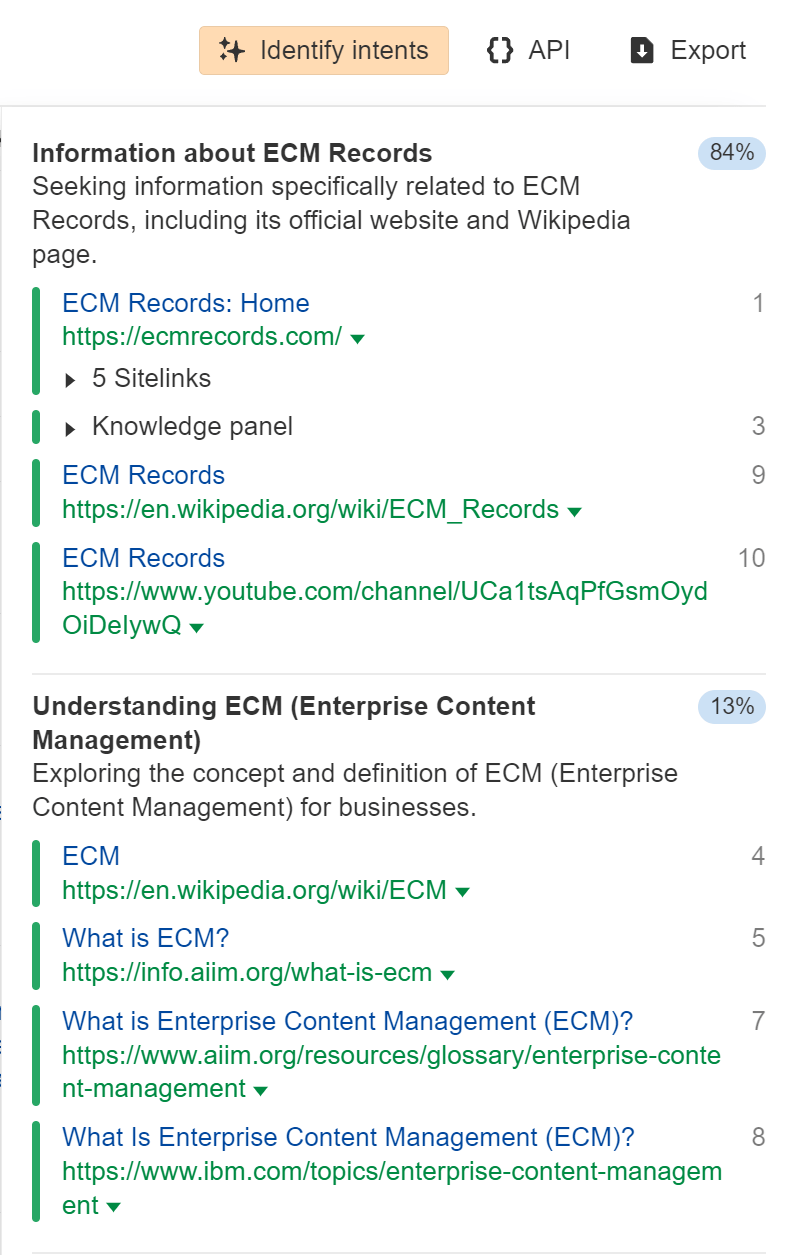
Granular keyword data
On the Overview report in Keywords Explorer, you’ll find things like the distribution of paid/organic, mobile/desktop split, the distribution across search type like web, image, video, or news.
These help you understand the format searchers prefer.

Competition monitoring
You can add competitors on the dashboard to keep an eye on their overall stats and how you compare. This is useful for creating competitor scorecards.

You can use Content Explorer to keep an eye on your competitors’ newly-published pages and pages that they have updated.
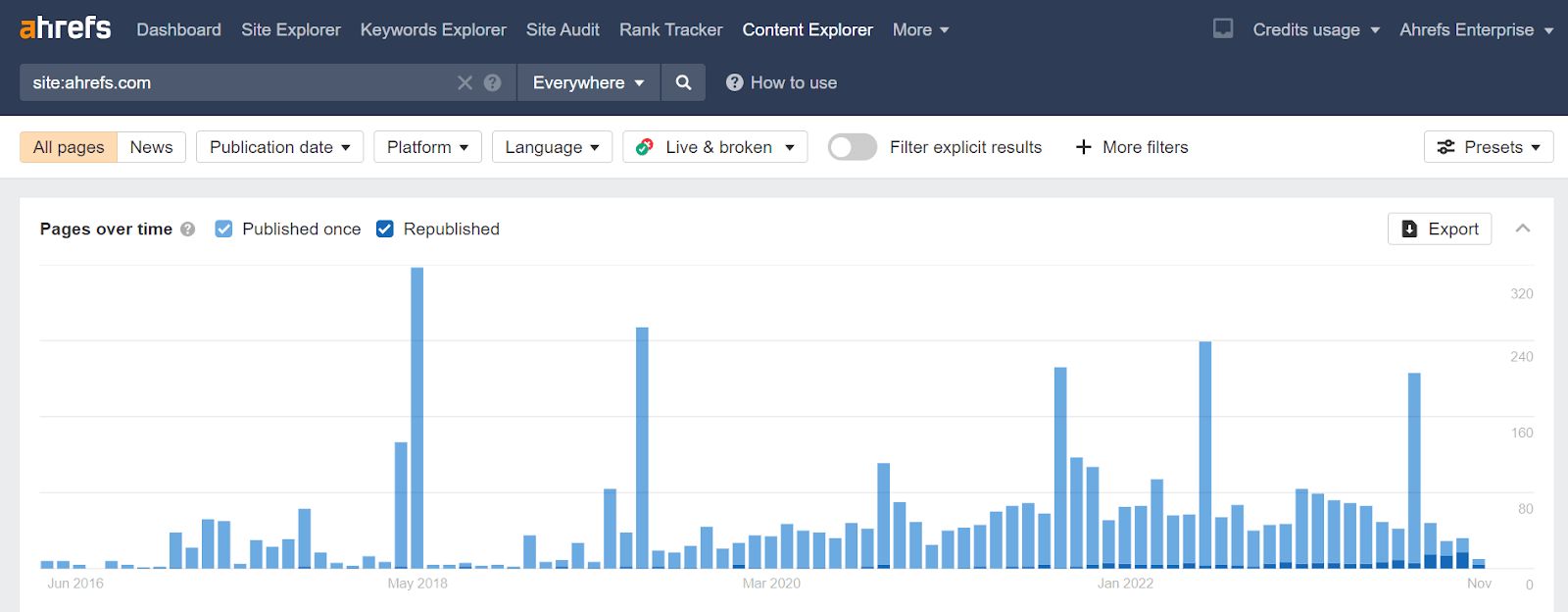
If you create a Portfolio on the Dashboard that includes competing websites, you end up with some pretty interesting views in other reports. For instance, you can get winners and losers for pages and keywords across all of your monitored competitors.
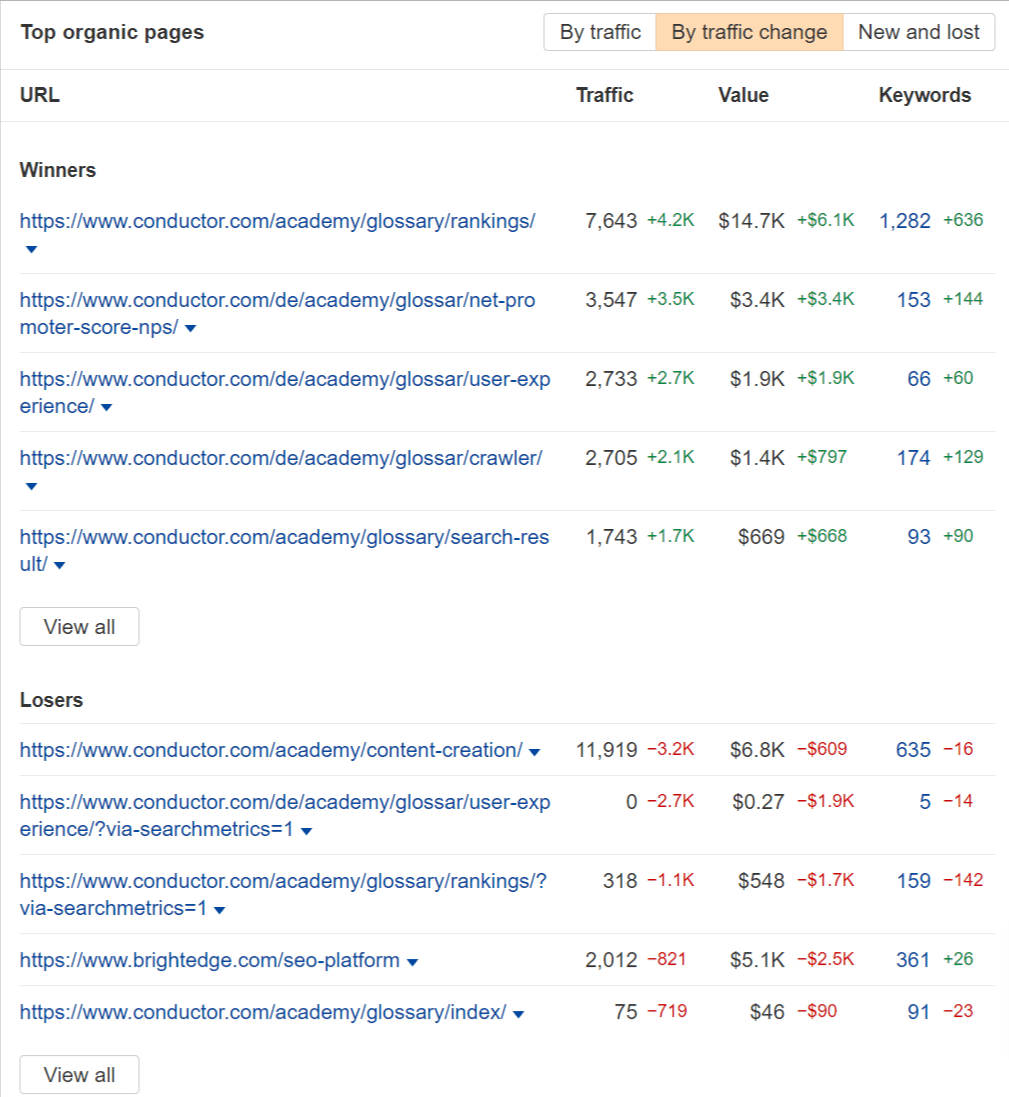
You can also see new and lost pages and keywords to see what is working well for your competitors and what they’re getting rid of.

Page inspect shows you the history of page changes over time. The darker the color, the more content changes were made on a page that day.
For example, this square on Jan 8 is a deep green. Clicking it shows you the exact things that have changed on this page – in this case, a huge content update.

YoY trends
You can also look at YoY trends for your own site. You may want to use your GSC or analytics data if you have it, but GSC is typically limited to 16 months of data. If you’ve connected it to Ahrefs though, we store and show a longer period of time and you’ll eventually be able to show the YoY data for this for multiple years.
You can also use the Years tab in Overview along with average volume to show general trends or issues. We show trends for Organic Traffic Value, Organic Traffic, Referring Domains, Domain Rating, URL Rating, Organic Pages, and Crawled pages.
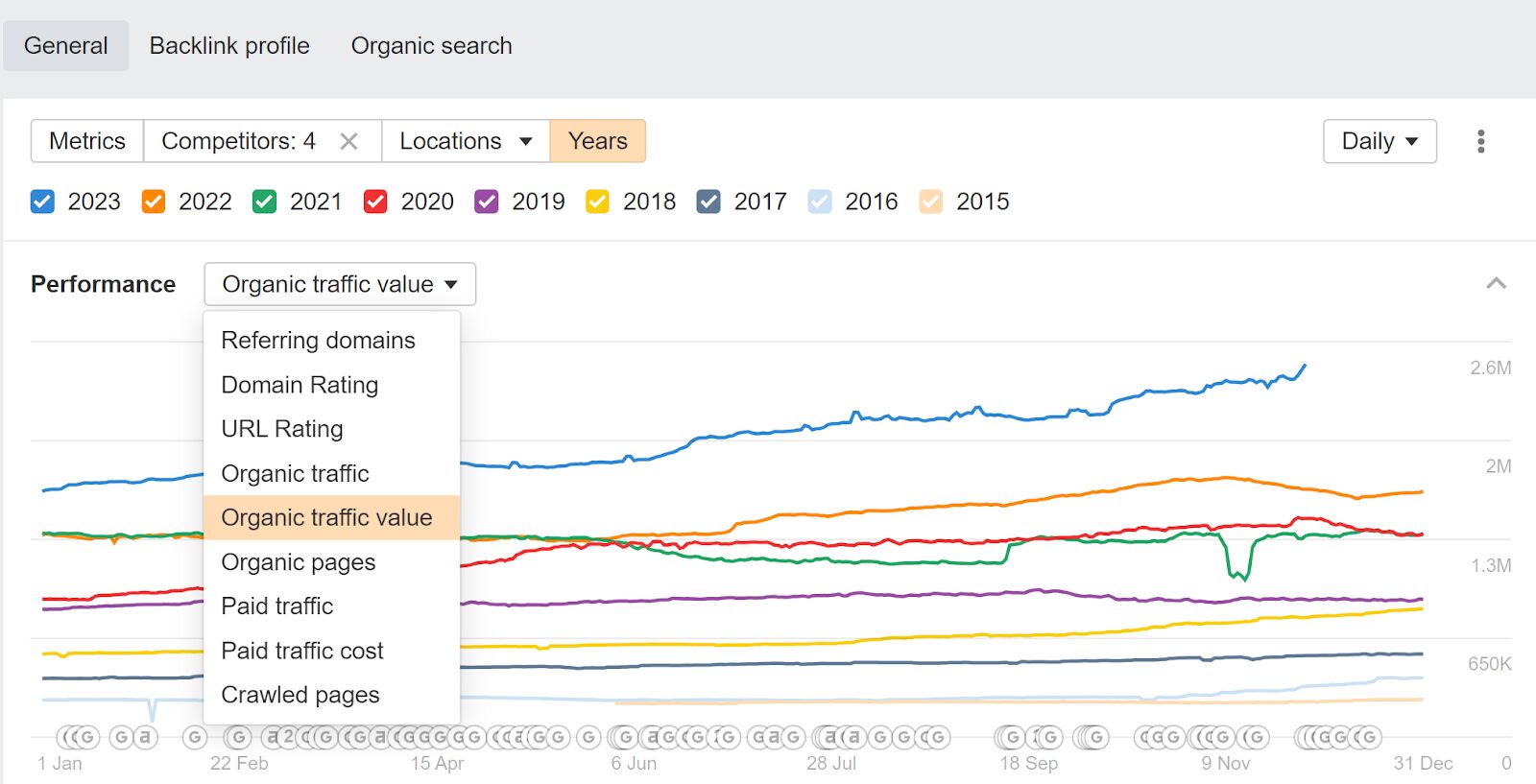
Critical page and keyword monitoring
Enterprise companies will typically have some kind of top pages or top keywords project. These look at the most critical pages and/or keywords for your business and help you see their performance over time and any trends or issues.
They’re typically used in meetings where there is a quick analysis and an action plan created for any issues or for any successes. You try to look at what worked well so you can replicate it, and try to look for any issues to see what happened.
You can use the Compare pages tab in the Top Pages report in Site Explorer to get this kind of view for your pages. We will be adding one for the Organic Keywords report in the future as well.

Crawl comparisons
Select any two crawls for comparison.
For example, you can compare a recent crawl for your website to a crawl back in, say, January. Click on the organic traffic changes column to sort your results and quickly find pages with significant traffic drops during this time.

Or, go to All issues to track how you’ve been dealing with technical issues on your site since then.

Track Rankings
Rank Tracker allows for custom segmentation via a flexible tagging system. You can have branded and unbranded, specific product or business unit tags, authors, top 20, or any number of groupings for your own use cases. There are a number of different things you can track, but lots of people typically want to see rankings.
![]()
Winners & losers for pages and keywords
You’ll want to check your own pages and keywords to see what’s working well and what’s not. You can do this on the Dashboard or with filters on the individual reports to see more data.
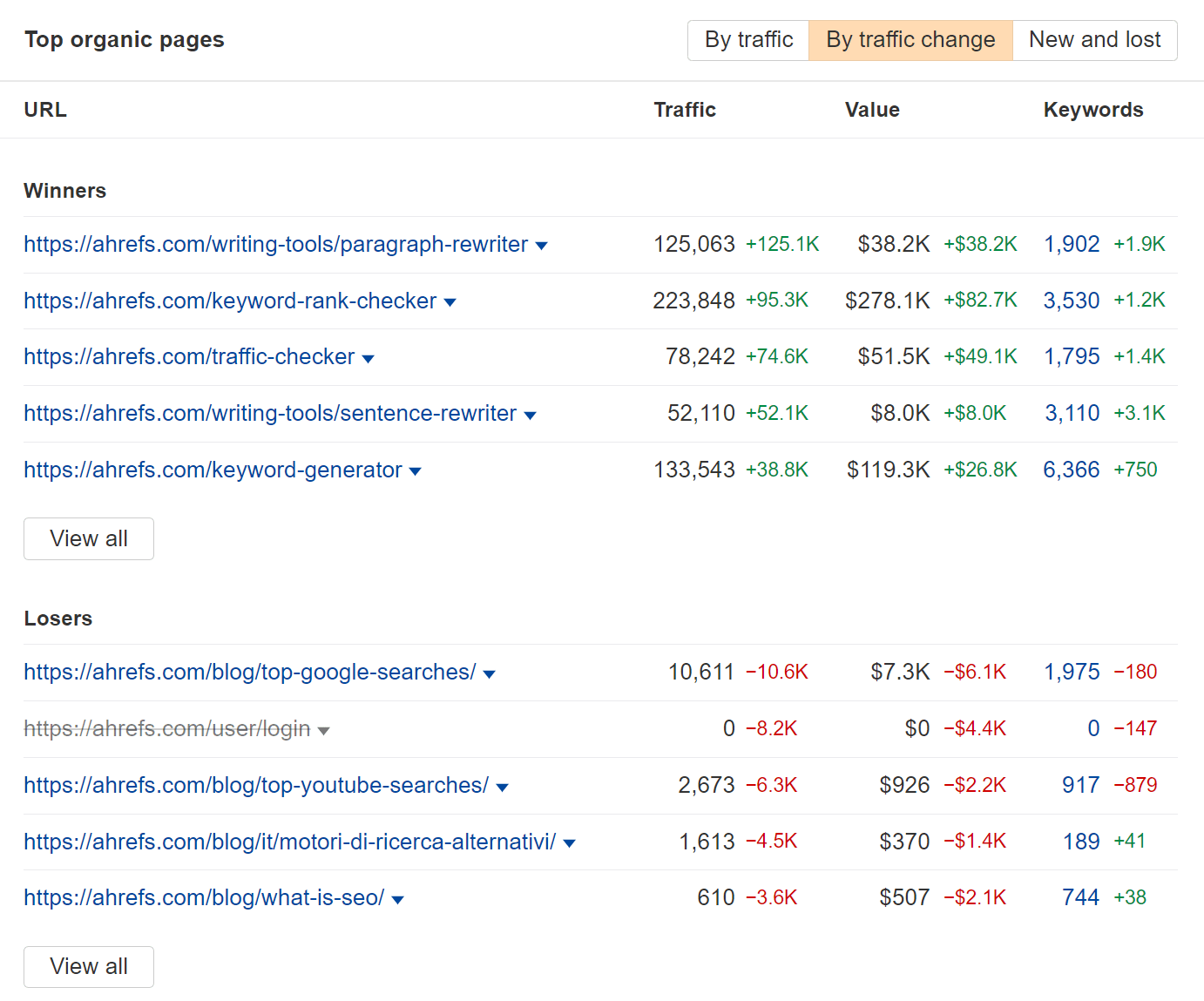
New & lost for pages and keywords
As an enterprise SEO, you can’t be everywhere at once or have visibility on every project happening on the site. You can use the new and lost reports for keywords and pages to help monitor what is changing on the site. Again, this is available on the Dashboard or you can filter for them in the individual reports like Organic Keywords or Top Pages.
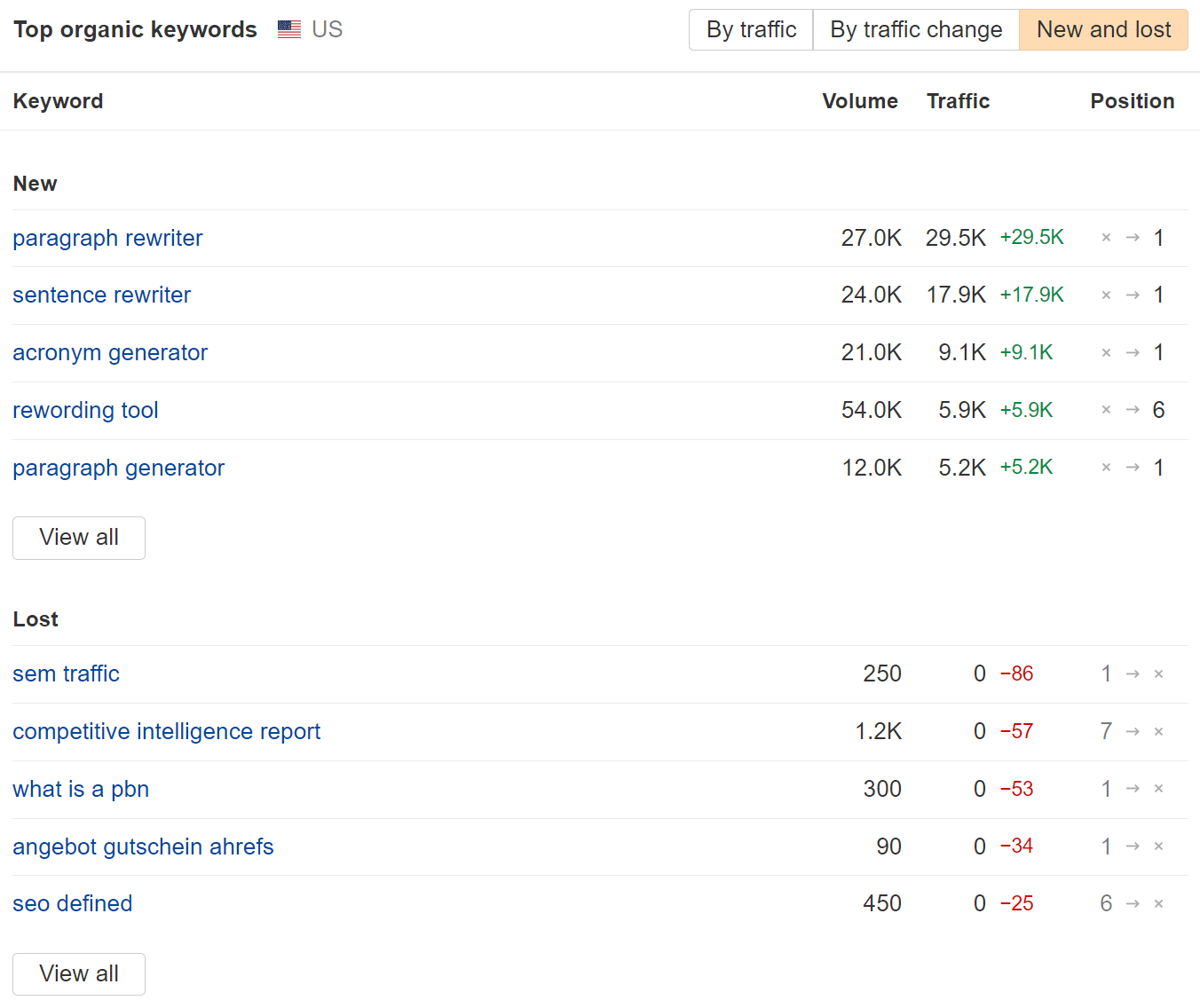
Content performance
If you’re running A/B tests, improving a group of pages, or want to monitor different authors or even business units or products who may have multiple sections, you can use the Portfolio feature on the Dashboard to add up to 1,000 pages or sections across 10 domains.

Many of the reports in Site Explorer will give you rolled up views of the content. Now you can easily see if your tests or improvements had an impact or create a scorecard view for different authors or parts of the business to check how each is doing.
Compare SERPs
The SERP comparison feature in Keywords Explorer lets you:
- See how the SERP for a given keyword has changed over time. Dig into the winners and losers in detail to figure out what Google likes or dislikes. This is especially useful when analyzing Google algorithm updates.
- Compare the SERPs for two relevant keywords to see how much overlap there is and if you can target both keywords with the same one page, or if you should create a dedicated page for each of the keywords.
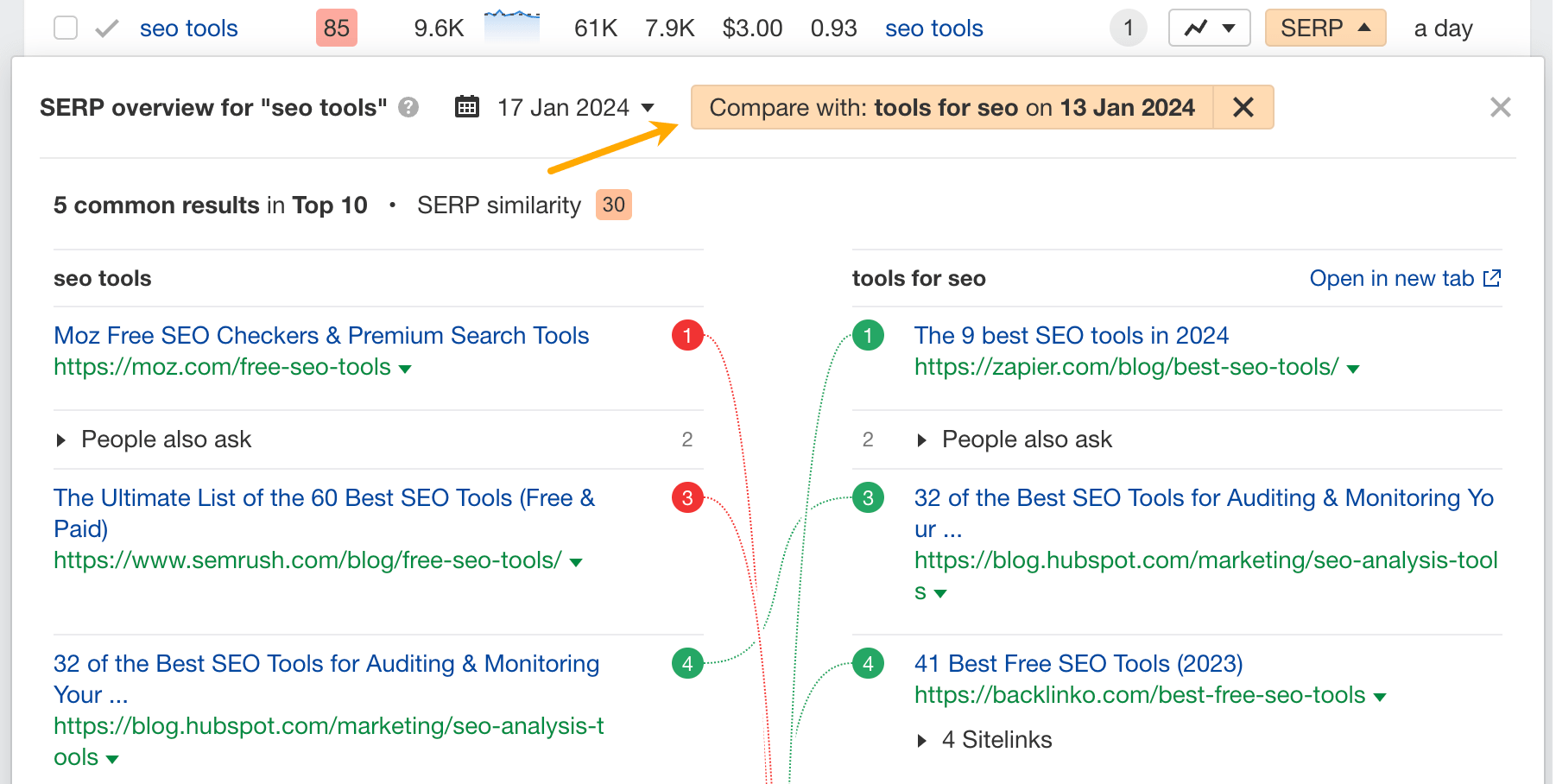
Hreflang cluster visualization
We have a first-if-its-kind hreflang cluster visualization. It shows and tells you what is broken, making it much easier to explain to stakeholders than the typical spreadsheet.
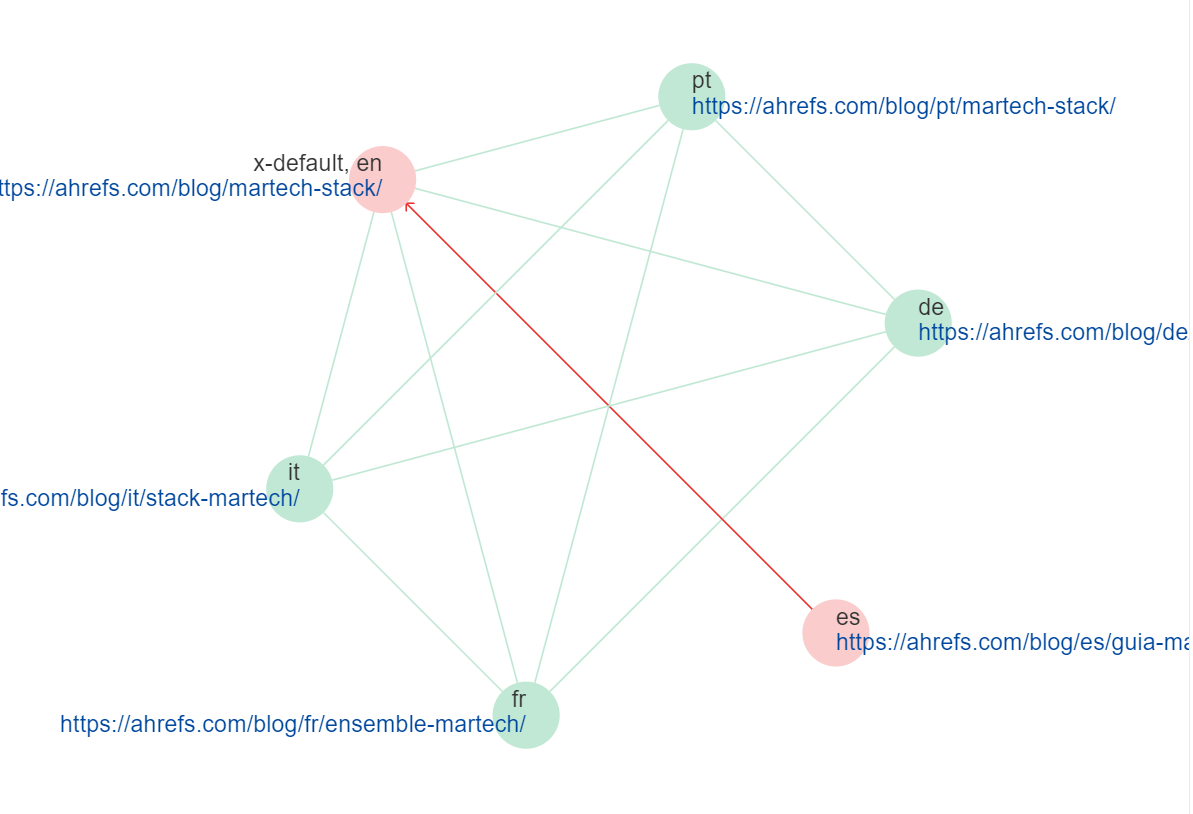
User management
We have everything from single sign-on (SSO), to two-factor authentication (2FA), user controls, audit logs, and more.
Also check out our API & Looker Studio reports
In most of our reports, we have an API button that will let you pull the data needed from the reports to re-create the visuals we have or any custom ones you want to create in your own reporting platform. We tried to make this as easy as possible for everyone. You can also check our API documentation for any custom data pulls you might want to make and our guide to enterprise SEO metrics, reporting, and dashboards has lots of ideas for things you might want to include in your reports.
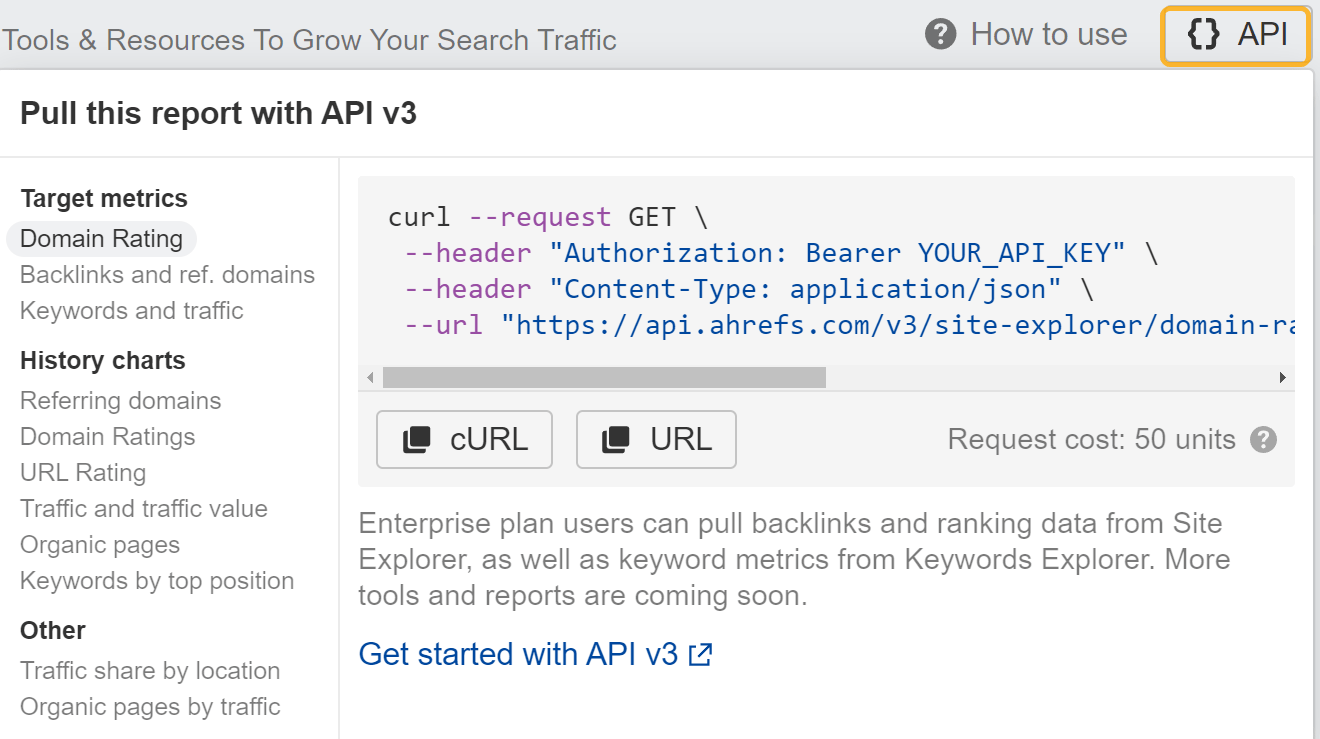
We also have Looker Studio templates you can use to create your reports. These are customizable and well documented.
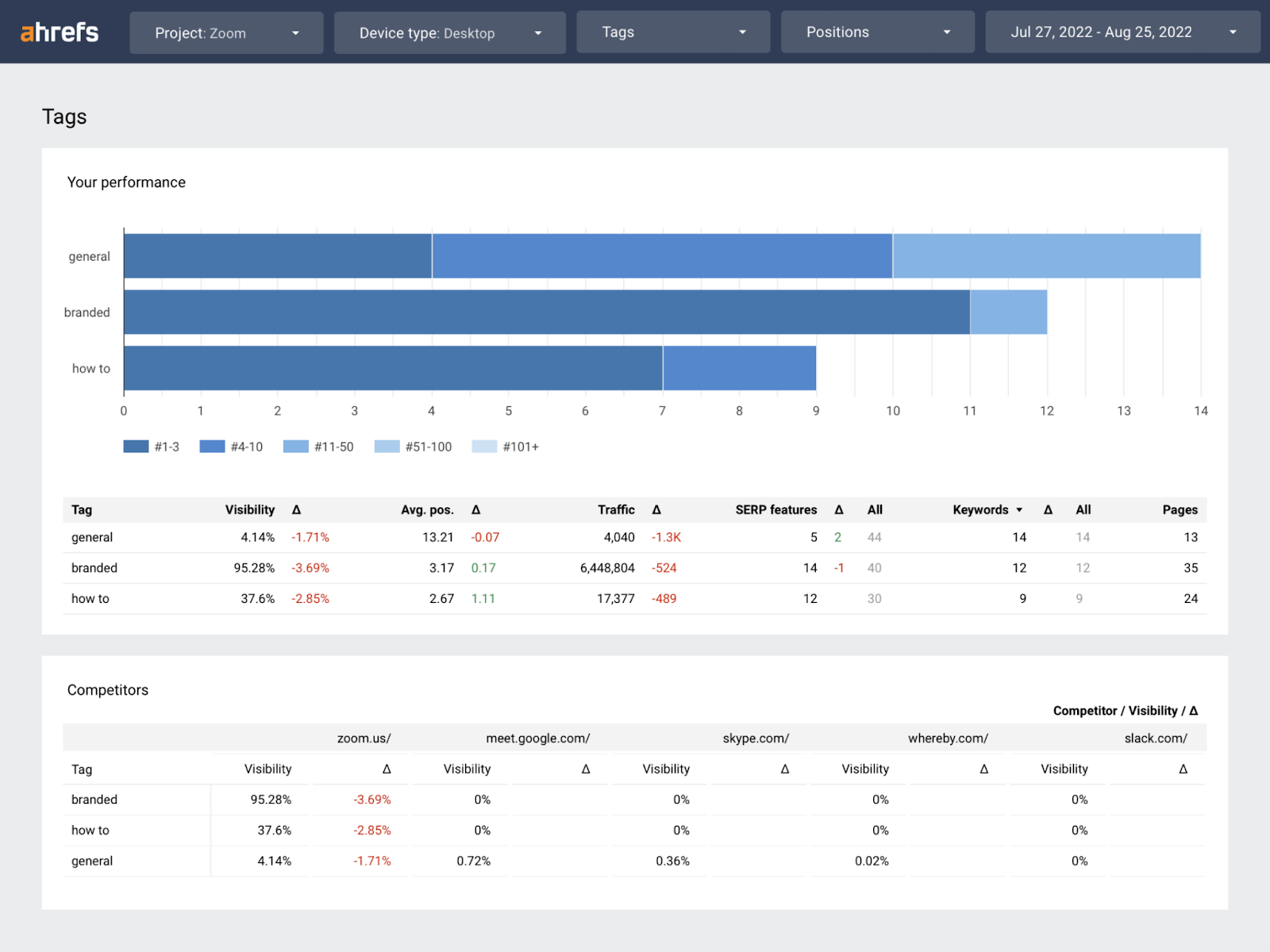
Making your content marketing successful takes a lot of work. Here are some of the things you can do as part of your enterprise content marketing strategy.
Create new content
There are many different types of content you can create, but with limited resources, enterprise companies typically focus on bottom of the funnel content.
You need to find a way to expand to the top of funnel content such as informational content and videos. This helps to expand your pipeline and gives you the opportunity to be seen as the expert instead of your competitors.
Every touchpoint for a brand is a chance to gain more awareness and credibility, that will eventually lead to conversions. Eventually, you’ll want content targeting every stage of the funnel.
What content should you create?
I like to start with my competitor’s top pages rather than starting research with a list of keywords. If you export and combine this data, you end up with a list of your competitor’s most successful content, and you can start with the content you know already works and is likely driving value to a competitor. I talk about my process for this in our article on how to create great content.
Every team I ever worked with, whether product-focused or marketing-focused, loved to see this data. You may want to keep track of your content creation in Google Sheets or Airtable.
Alternatively, you can use the Content Gap tool to find these opportunities, but you may see some repeated opportunities because of similar keywords. We will update this to add clustering and help reduce this extra noise.
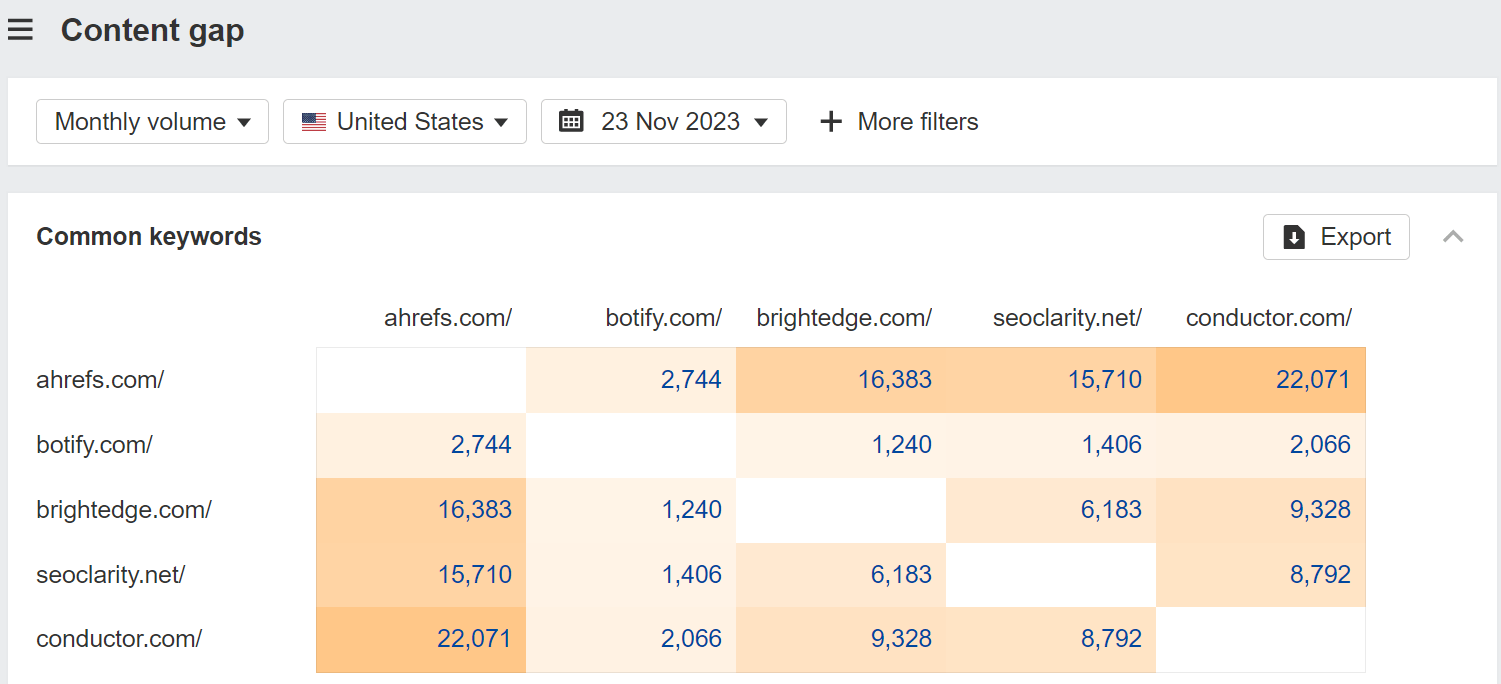
For now, you may want to export the keywords from the Content Gap tool, paste them into Keywords Explorer, and go to the “Clusters by Parent Topic” tab. This should give you actual content opportunities you may not be covering.
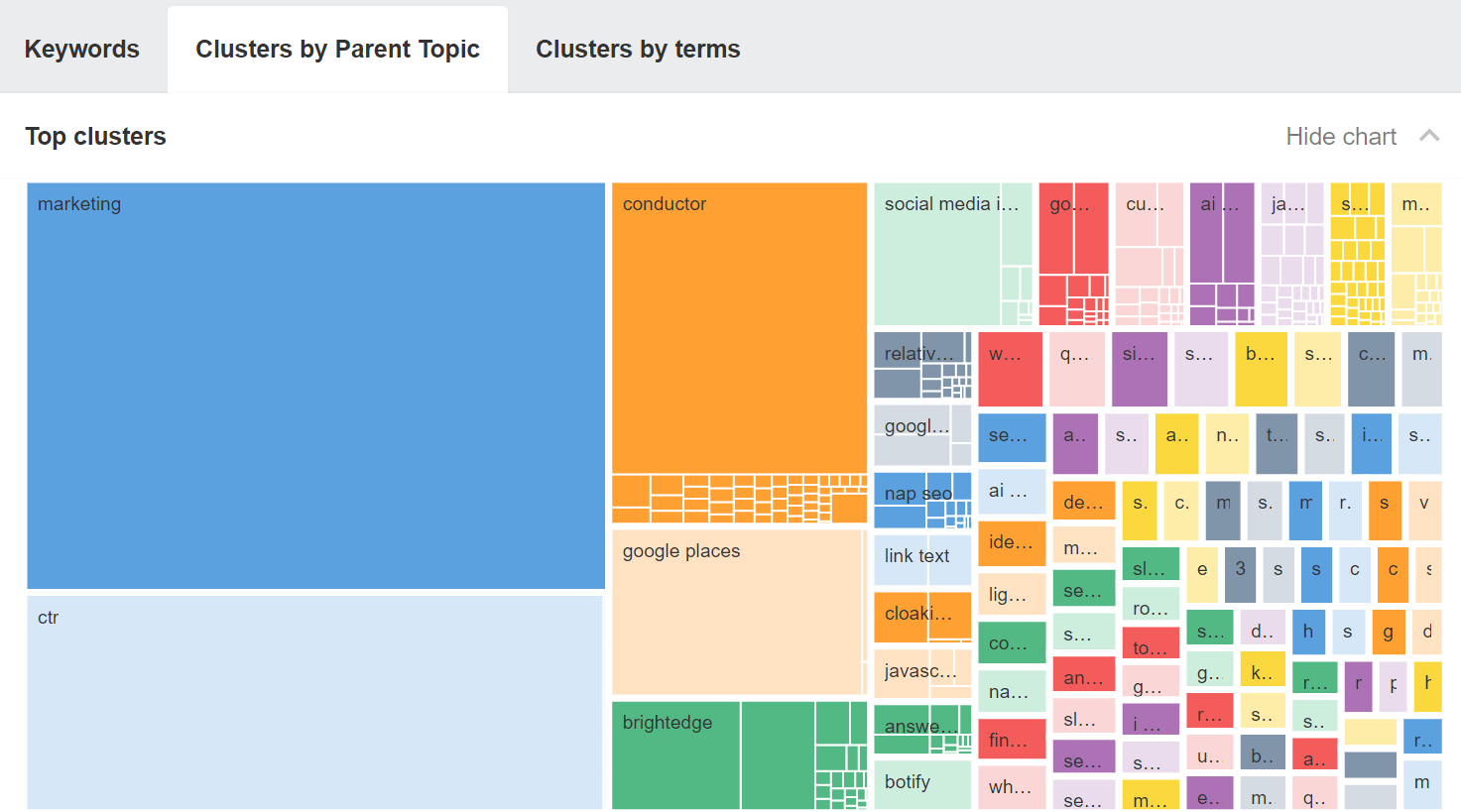
Improve existing content
Making your existing content better can lead to quick wins. Here are some things you can look for.
Content with declining traffic
Apply a filter for “Traffic: Declined” in the Top pages report in Site Explorer and set your time period for the last 6 months or a year. Take a look at pages that lost traffic to see which ones are important to you and that you think you can improve.
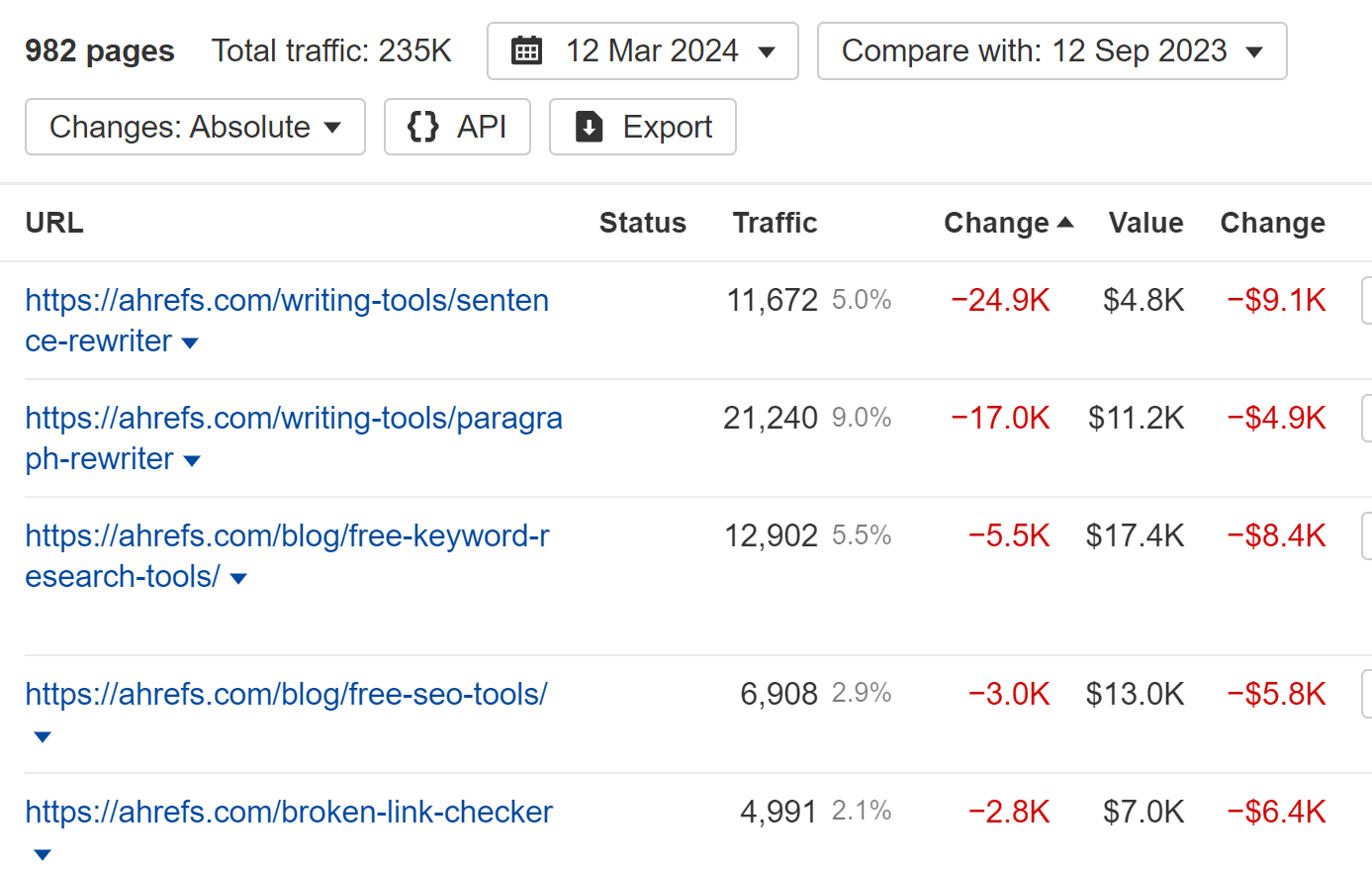
Low-hanging fruit
One common way to prioritize content improvements is to check for low-hanging opportunities, like pages ranking in positions 4-15 for their main keyword. You might be able to quickly improve these pages’ content to rank higher and get more traffic. Use Google Search Console or the Organic Keywords report in Site Explorer to find pages that fit the bill.
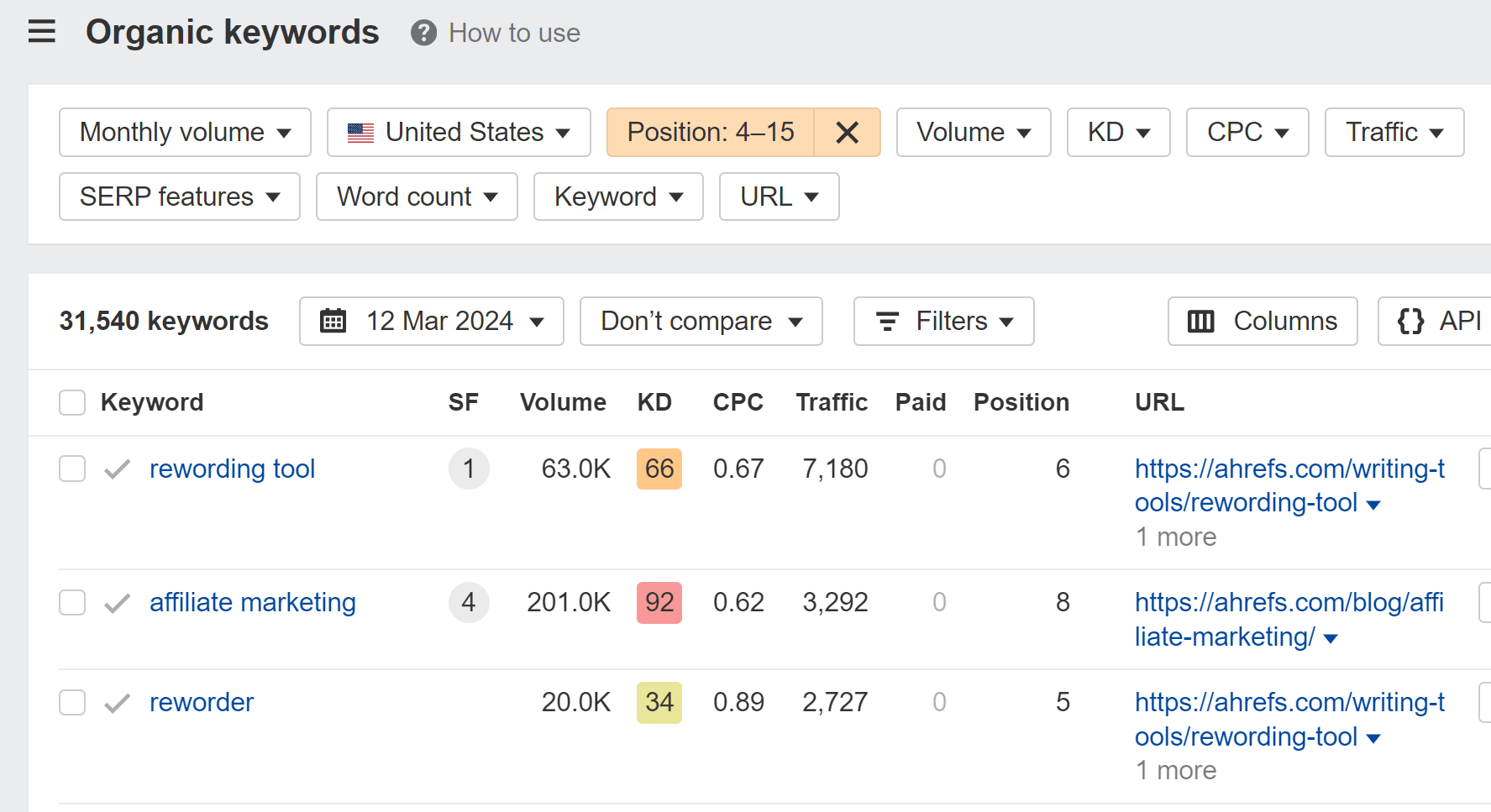
Optimize for featured snippets
For informational content, targeting featured snippets can skyrocket you to the top of the SERPs.
Here’s how to find the easiest opportunities:
- Go to Ahrefs’ Site Explorer
- Enter your domain
- Go to the Organic keywords report
- Filter for keywords in positions #1–5
- Filter for keywords that trigger featured snippets “where target doesn’t rank”
- Look for keywords where your page is missing the answer, then add it

This is arguably the most important section that you can write if you want to rank for informational queries. You can see what is already eligible for a snippet and the kind of things that these snippets mention, along with why one may be better than another. Now you just have to make something that’s better.
Here’s an example: For “how to create content,” the main snippet is from inc.com:
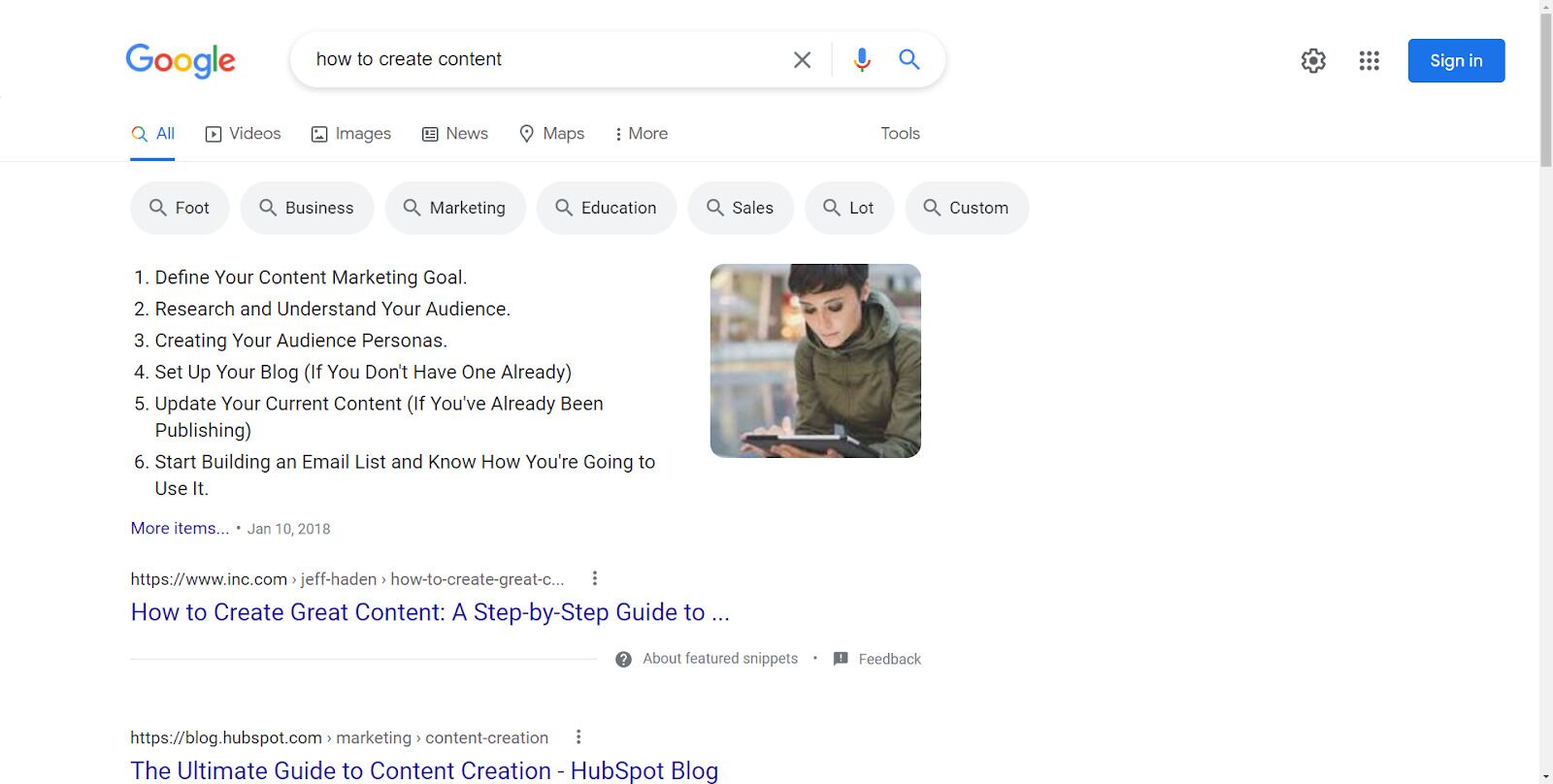
If you append “-inc.com” to your search, you’re removing this site from the results and can see the second eligible featured snippet from hubspot.com:
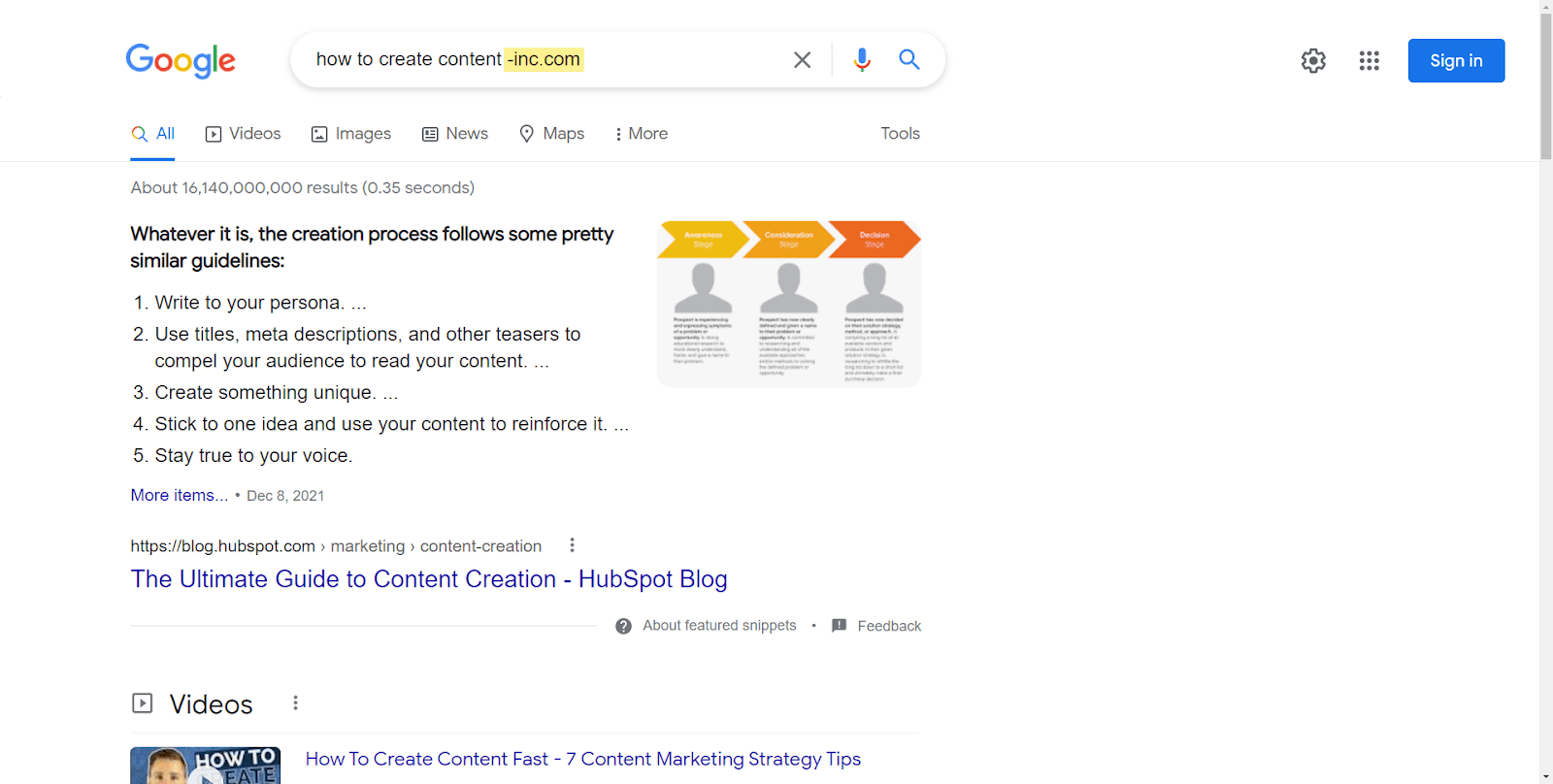
You can repeat this process, removing more sites from the results to see more eligible featured snippets. Also, you can glean insights into what it takes to get featured snippets and figure out why one may be considered better than another.
For some head terms that are more informational in nature, you may have to refine the query as “what is [head term]” for this to work.
Translate successful content
Most enterprise companies operate in many countries and in many different languages, and their enterprise SEO teams will have to work on international SEO. If you have content that’s working well in one language, it’s likely going to work well in another language as well. You should translate successful content for those other languages
We’ve had success with this at Ahrefs despite allocating minimal resources to this process. It’s one of the areas where I expect massive growth as we start to focus on it more.
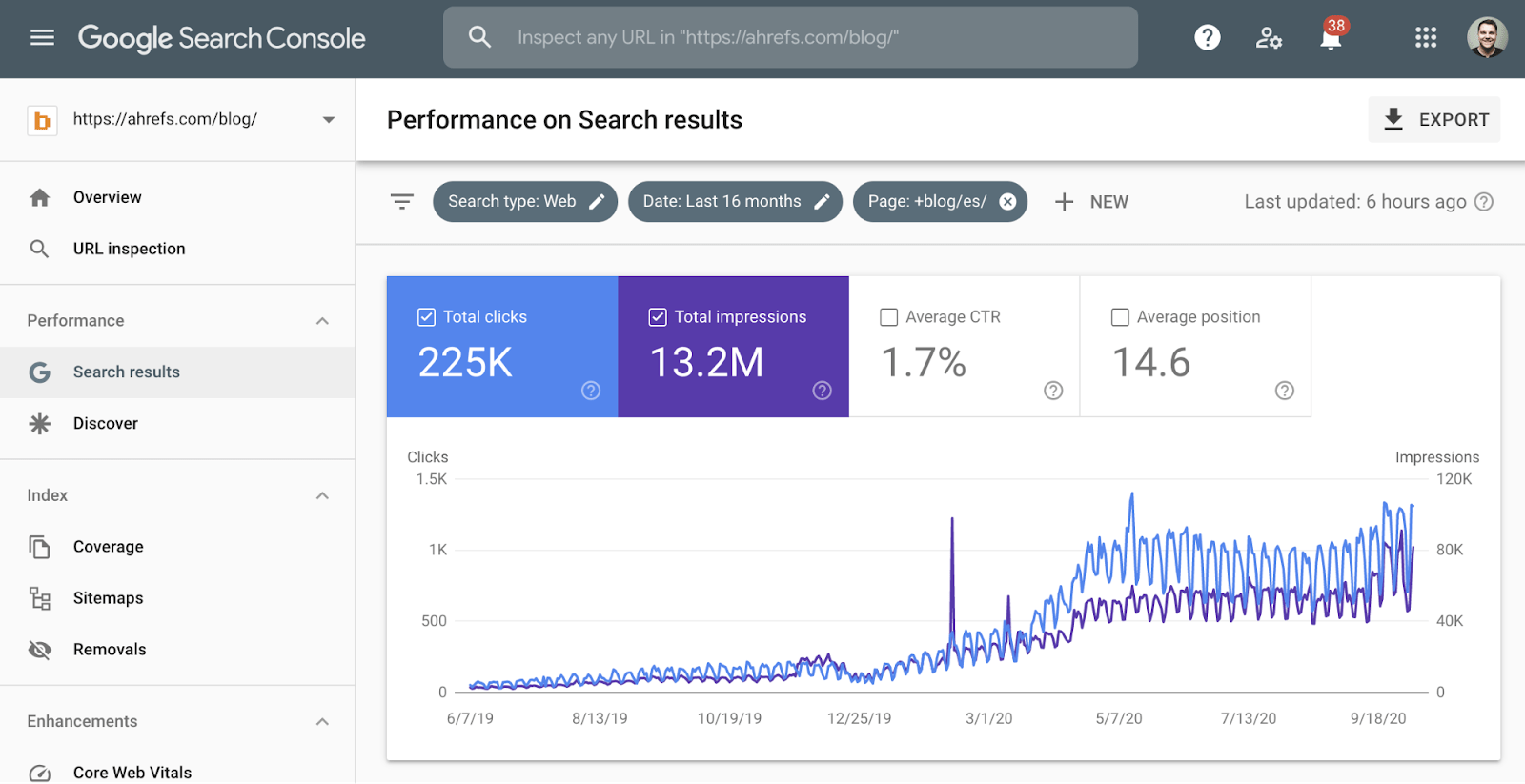
Create branded content, sometimes
You’re probably going to run into content that is too brand-focused, too product-focused, or even too keyword-focused. People will ask you to rank for terms with pages they control that don’t align with search intent. A good example is someone wanting to “sprinkle some keywords” into their product page to rank for an informational term.
You can use the “Identify intents” feature in Keywords Explorer to show the main intent of each term and the percentage of traffic to each result. A product page for “enterprise content management” isn’t likely to rank for this query as the main pages ranking are informational intent.

Sometimes, there may be one product page ranking for terms like this where you have a shot at ranking, but it’s usually the most popular product in that position.
There are times you may want to optimize and even create content for branded terms, but this shouldn’t be your usual strategy. Nor should you “sprinkle some keywords” into brand-or-product-focused pages to try to rank for informational terms. These pages may be full of marketing or sales jargon and not have the content you actually need to rank.
Many enterprise websites get a lot of their overall traffic from branded searches, and they may not rank well for unbranded terms. Branded traffic is a good thing. It’s high-quality and converts well, but you should be getting it even without SEO help.
The exceptions to that may be for terms related to companies that were acquired or products that were renamed. You may still need content or documentation to help you keep traffic for those terms and direct people to new versions of the product.
Syndicate content
Content syndication is when one or more third-party sites republish a copy of content that originally appeared elsewhere. It frequently happens with news content, although, to be honest, any popular site is going to have scrapers and enterprise sites may have a paid syndication strategy.
There are a lot of benefits to syndication, including increased reach. Check out our article on content syndication to learn more about it and how to follow best practices.
Redirect relevant old content
In many cases, your old URLs have links from other websites. If they’re not redirected to the current pages, then those links are lost and no longer count for your pages. It’s not too late to do these redirects, and you can quickly reclaim any lost value and help your content rank better.
Here’s how to find those opportunities:
- Paste your domain into Site Explorer (also accessible for free in Ahrefs Webmaster Tools)
- Go to the Best by links report
- Add a “404 not found” HTTP response filter
I usually sort this by “Referring domains.”
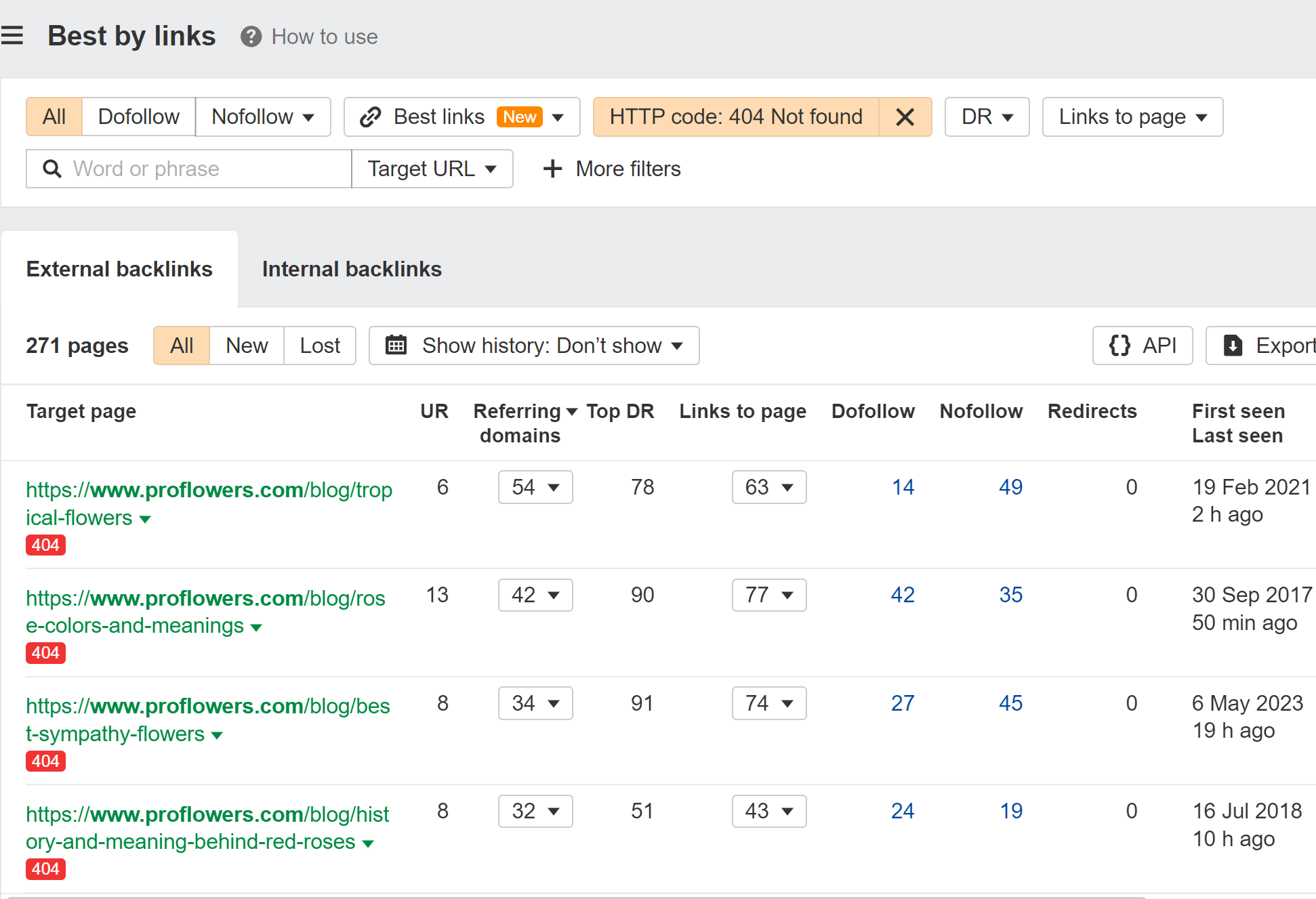
Build and improve internal links
I’ve always found internal links to be a powerful way to help pages rank higher. Even these links may be difficult to get in an enterprise environment.
Sometimes different people are responsible for different sections of the website or even different pages, which can make internal linking time-consuming.
On top of the political hurdles, the process for internal linking can be a bit convoluted. You either have to know the site well and read through various pages looking for link opportunities or follow a process that involves a lot of scraping and crawling to find opportunities.
At Ahrefs, we’ve made this simple, scalable, and accessible so anyone can find these opportunities with our tool in Site Audit. We look at what your pages are ranking for and suggest links from other pages on your site that talk about those things.

I’d also recommend watching out for opportunities to use better link anchor text. It’s common for page creators to overuse generic link anchor text such as “learn more,” “read more,” or “click here.” You can look for usage of this kind of generic copy in the Internal anchors report in Site Explorer.
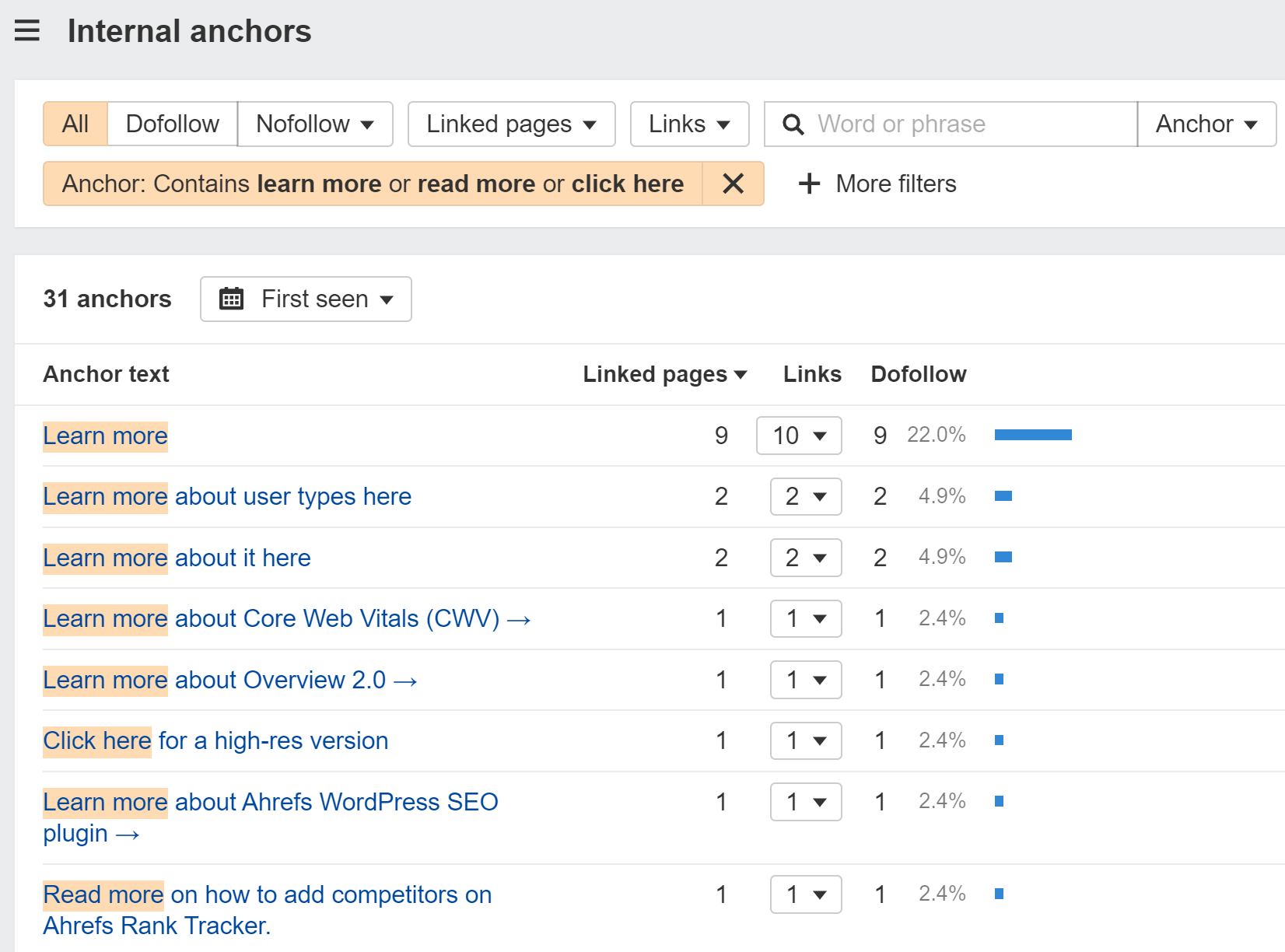
Create “vs” pages
Creating content that compares you against competitors can be difficult to create in an enterprise environment because of all the legal hurdles. I still think it’s useful to push for these kinds of pages so that you can control the narrative.
There are ways you can do this without having giant tables comparing each feature. Those are always biased anyway. For instance, on our vs page, we show what users think of us and talk about the quality of our data and unique features.
This page has done well for us, and I believe we will create more pages like it in the future.
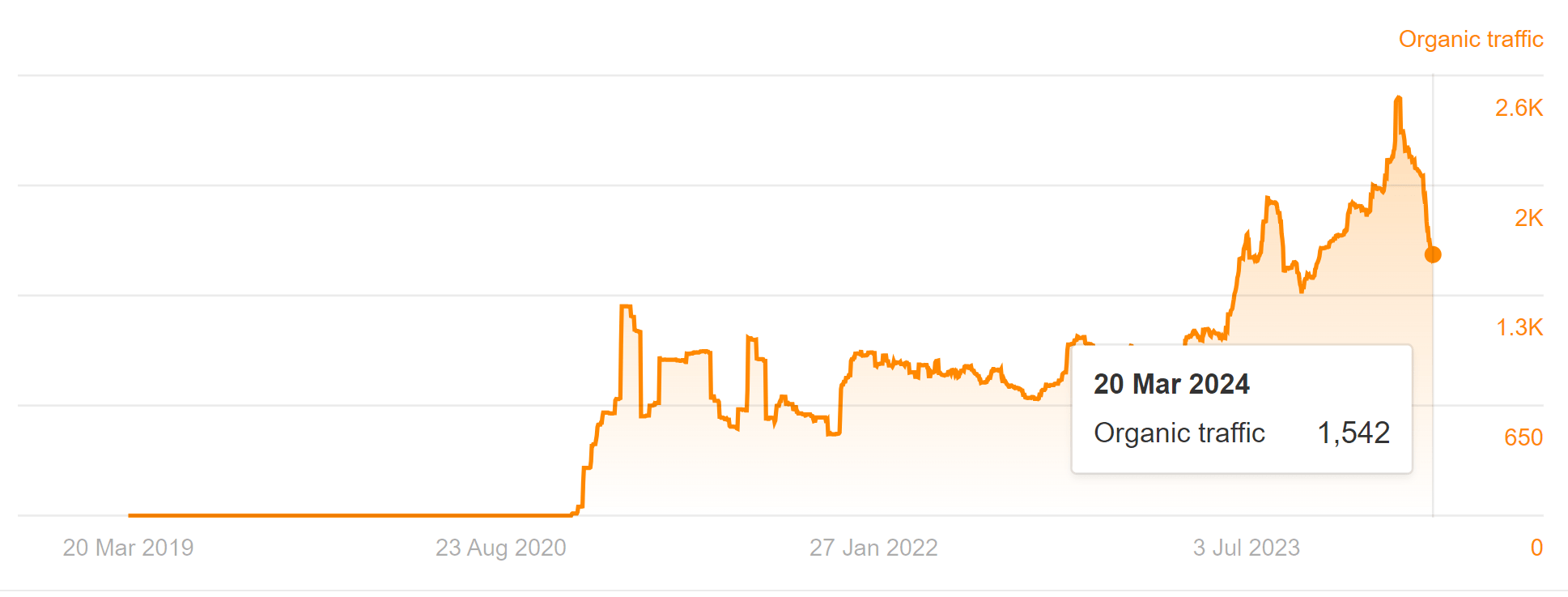
Create free tools
If you can create free tools around your product or data, you can use it as a lead-gen tactic for your main products.
We use this strategy at Ahrefs, and some of our most trafficked pages are from free tools. We even created a bunch of free writing tools, which we are starting to monetize.
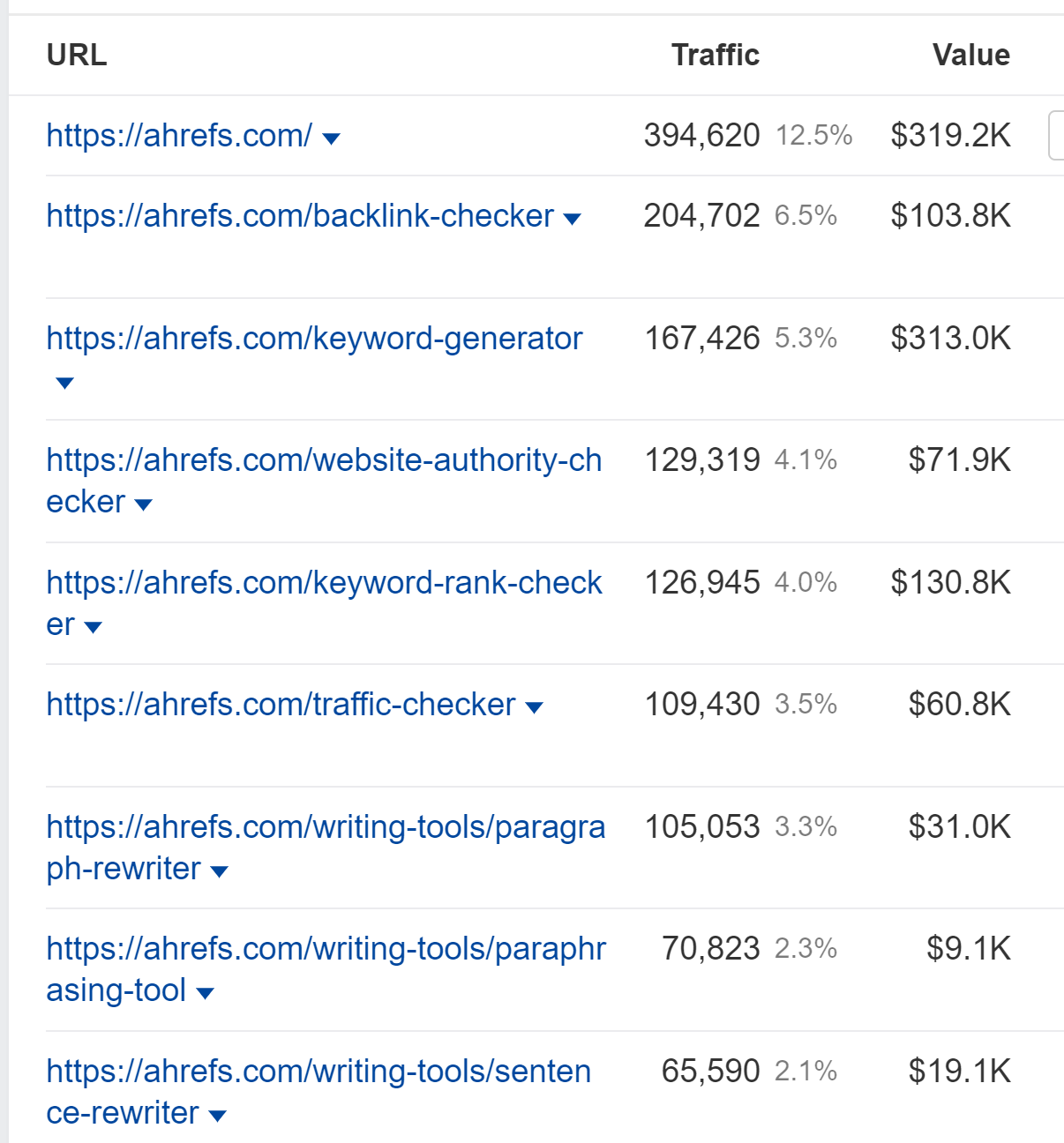
Create programmatic content
If you have the ability to create good pages programmatically using your data, it can be a great way to scale quickly.
We had some success with a small amount of effort by re-using components to create “SEO for x” pages, where x is different types of business. Most of these are ranking well already, but at some point I believe we will put in more effort and pull more data to make these pages even better.
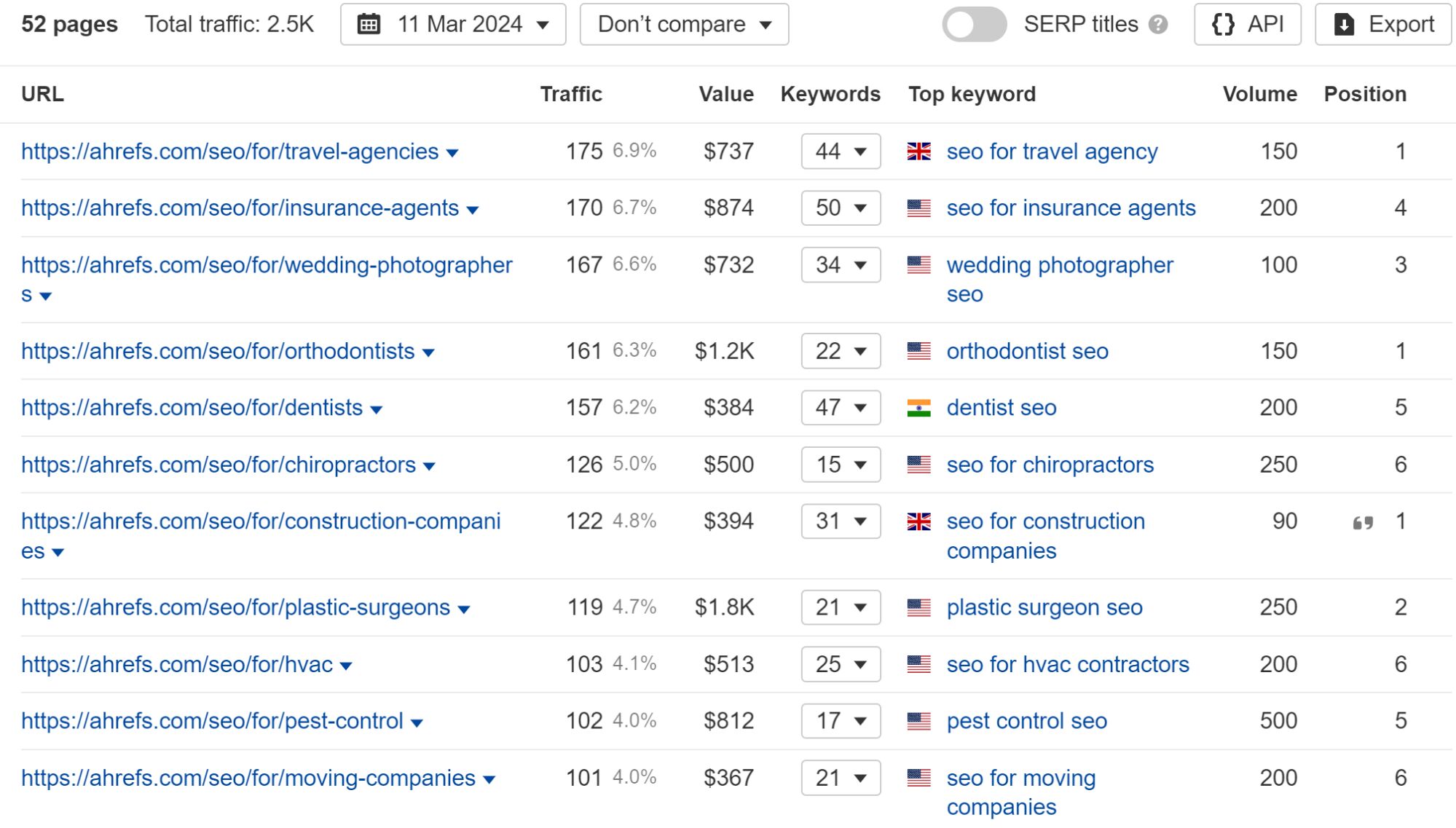
We’re working on some additional programmatic plays that showcase our data even more, and I expect will drive a lot of leads.
Create video content
Video content can work extremely well for businesses. Sam Oh drives tons of leads for Ahrefs.
Ahrefs YouTube has over 500k subscribers with less than 300 published videos. Many of those videos have over 1 million views!
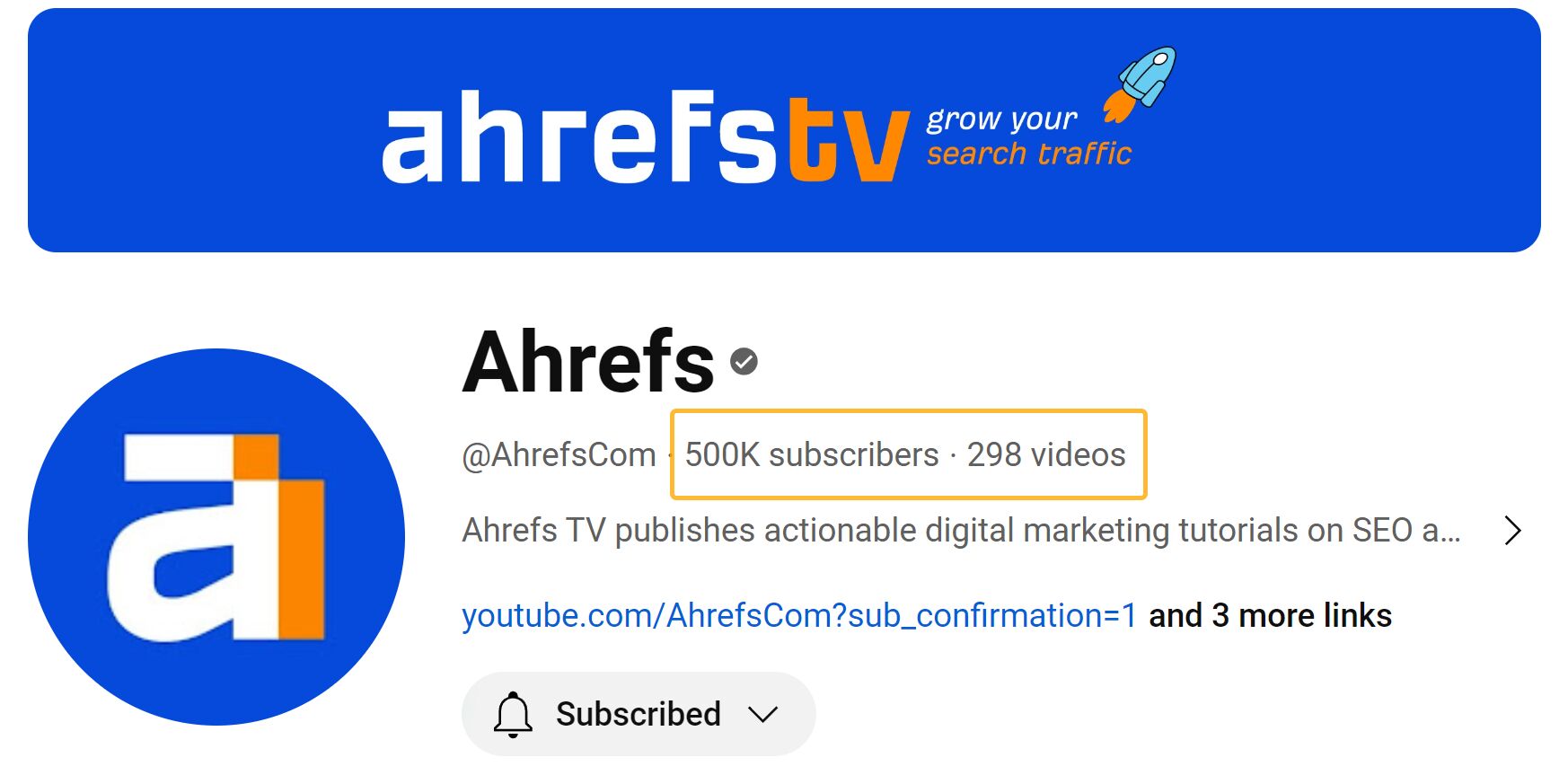
In my past jobs, I’ve always treated videos the same way I would blog content and structured the talking points around the things people are searching for and want to know. This worked extremely well, even for industries where people were convinced that folks in the industry didn’t watch videos.
Using Ahrefs for enterprise link building
[/post_nav_link]A lot of link building happens without SEO at the enterprise level. Companies are usually really active and doing different things. You may see TV commercials, hear radio ads, have a lot of new content. Then there’s public relations, social media, paid advertising, content syndication, events, corporate partnerships, influencers, celebrity advertising, affiliate programs, and more.
Most links will probably happen without you, but you can help guide many of the teams in charge of these channels with best practices.
You have a lot of different options for link building in an enterprise environment. If you’re not sure where to start, I’d check out the Links section in Opportunities report in Site Explorer. This report has shortcuts to other reports with filters applied, that help you with some common tasks.
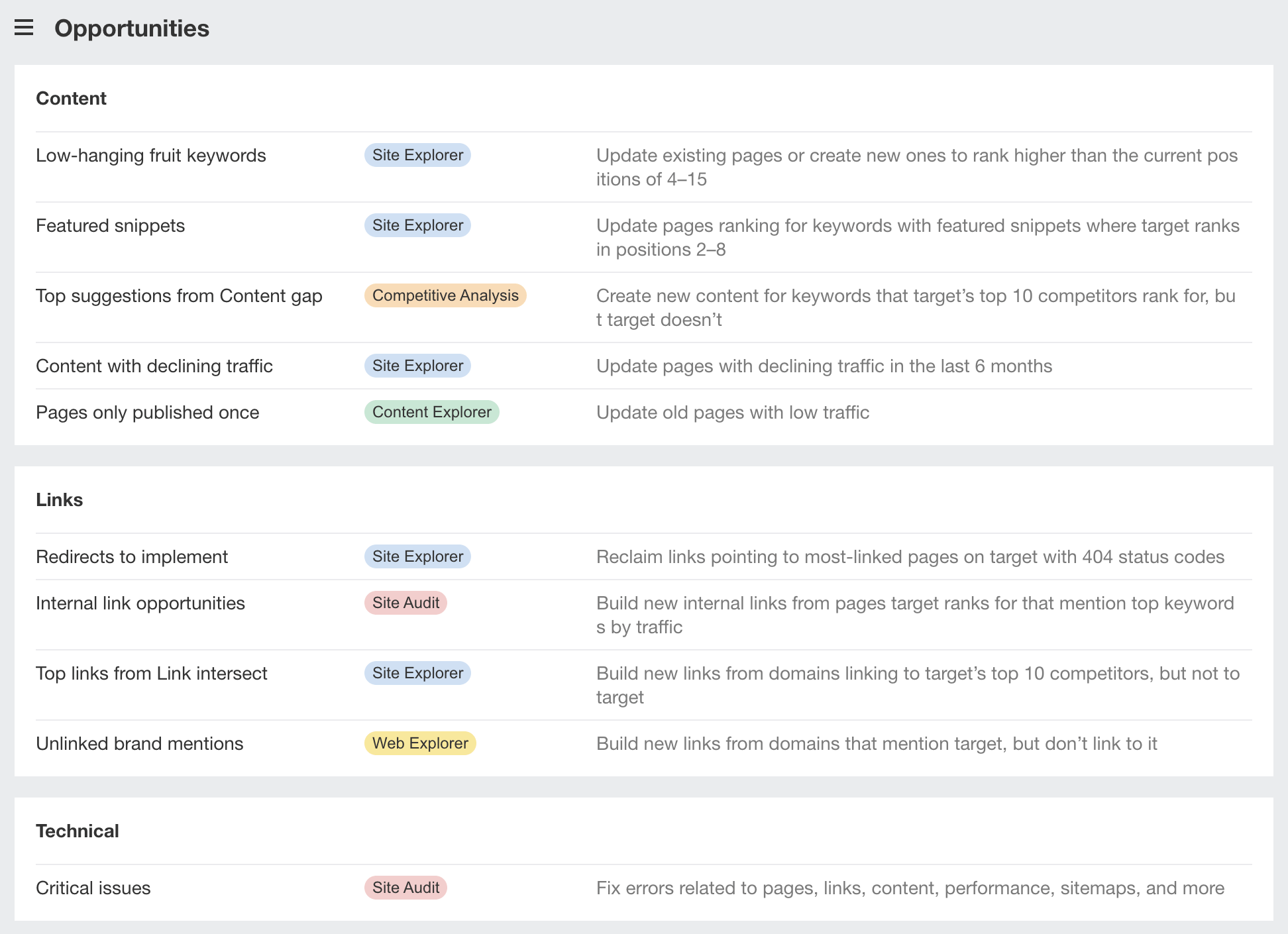
Here are some of the enterprise link building tactics you may want to try.
Create linkable assets
In SEO, we use the terms “linkable asset” or “link bait” to refer to content that is strategically crafted to attract links. Such linkable assets can take on many different forms:
- Industry surveys
- Studies and research
- Online tools and calculators
- Awards and rankings
- How-to guides and tutorials
- Definitions and coined terms
- Infographics, GIFographics, and “Map-o-graphics”
You can also use any industry-famous employees or thought leaders you have to create interesting quotes that might be linked.
There’s also a phenomenon where high-ranking pages get linked to more over time. If your content is good enough to get you near the top, you’re more likely to get more links. Tim Soulo calls this the vicious circle of SEO.
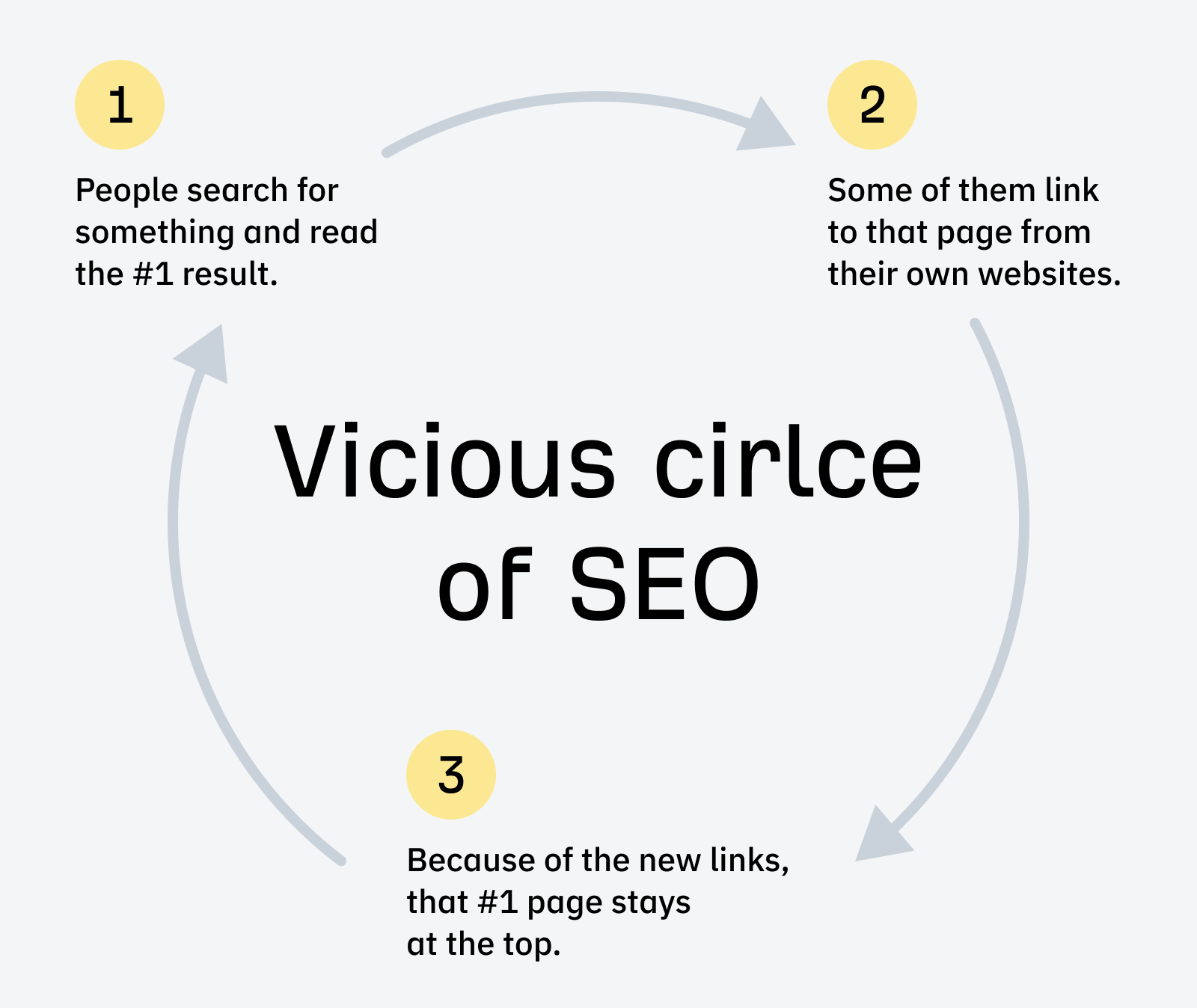
For more ideas, check out our guide to enterprise content marketing.
Combine similar content to create a stronger page
Keyword cannibalization is when a search engine consistently swaps rankings between multiple pages or when multiple pages rank simultaneously for the same keyword but are similar enough to be consolidated. Consolidating similar content into comprehensive guides or pillar pages can improve your chances of ranking and earning links. To do that, you usually combine the content and redirect one page to the other.
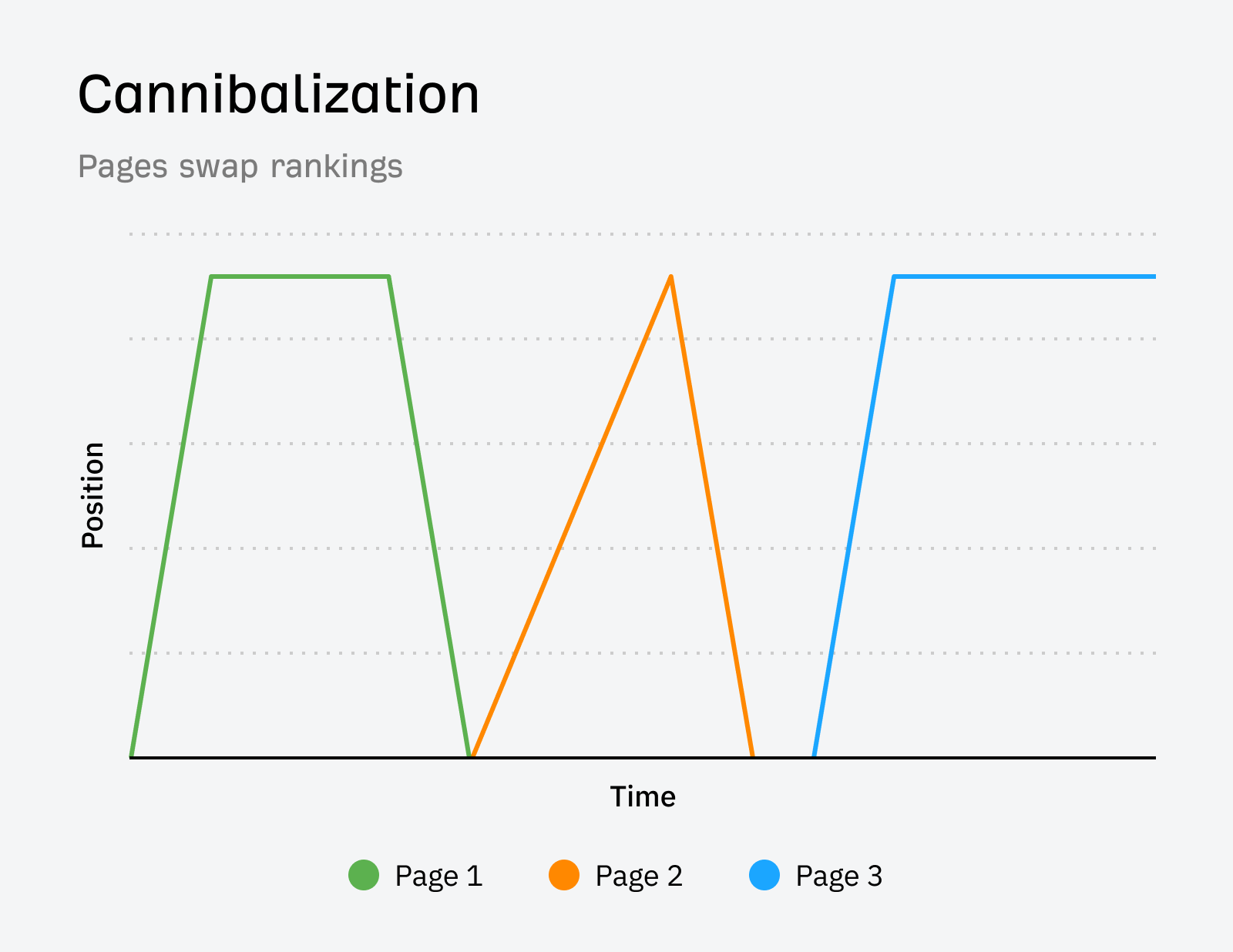
Promote your content
The more visibility your content gets, the more links you are likely to get naturally. Leverage those other teams I talked about earlier to promote your content on social and maybe paid media. Use influencer relationships to amplify your reach. Use your PR teams for potential media coverage.
Keep in mind that these other teams are busy and have their own priorities as well. Be selective on what you ask them to promote. If you ask for them to promote everything, they’re likely to promote nothing.
Go after unlinked brand mentions
Unlinked brand mentions are online mentions (citations) of your brand—or anything directly related to your brand—that do not link back to your site.
Enterprise companies tend to get talked about a fair bit, and each one of those mentions offers a chance to get a link. Even if there’s not initially a link, it doesn’t hurt to ask for one. You can use Content Explorer to find these mentions on the web, and the inbuilt filter for highlighting unlinked domains to hone in on unlinked mentions.
You can also look for unlinked brand mentions of key employees, famous quotes of theirs, or statistics from your studies.
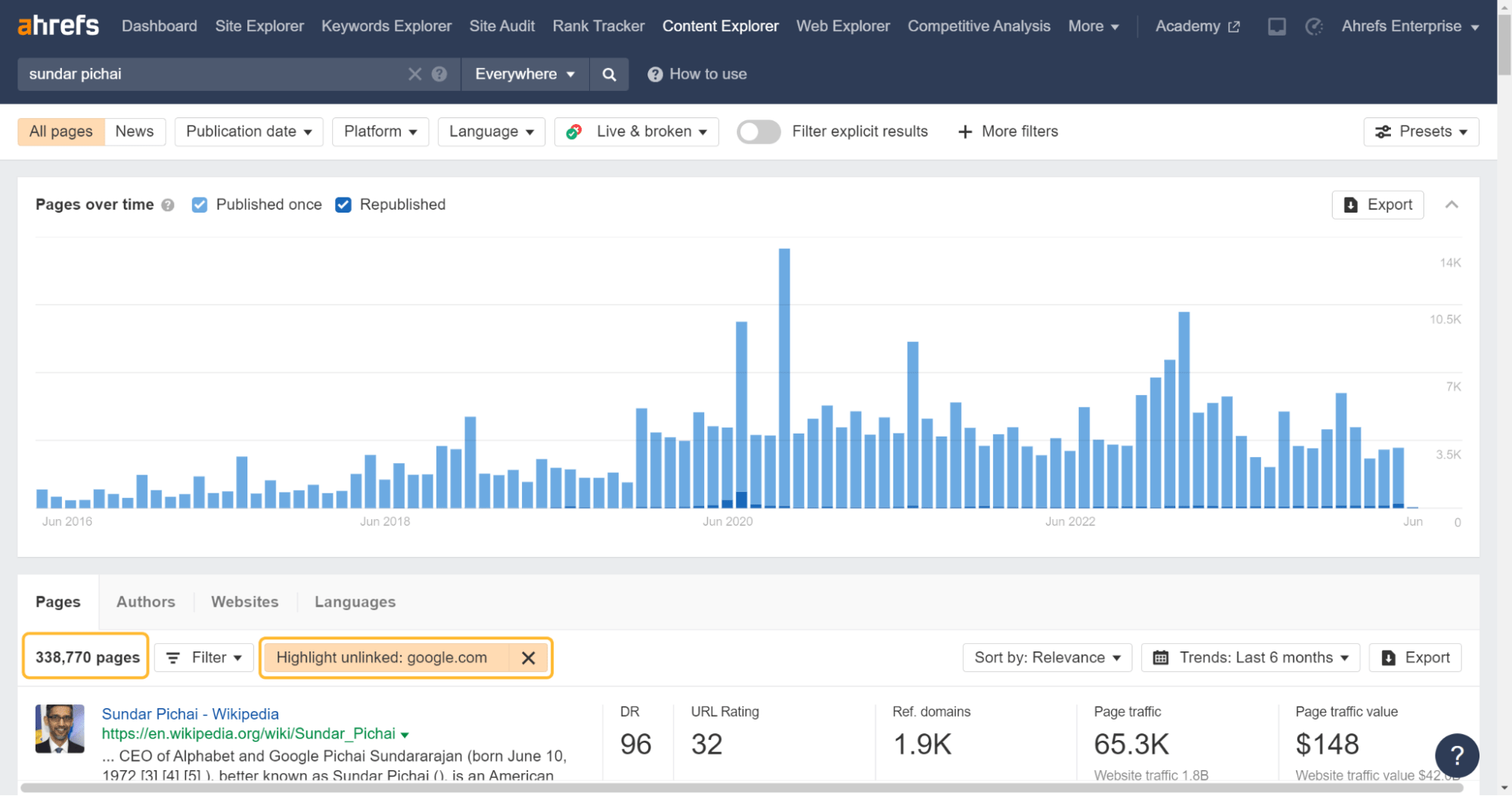
Recover links with link reclamation
Sites, and the web in general, are always changing. We ran a study that found that ~two-thirds of links to pages on the web disappeared in the nine-year period we looked at.
In many cases, your old URLs have links from other websites. If they’re not redirected to the current pages, then those links are lost and may no longer count for your pages.
It’s not too late to do these redirects, and you can quickly reclaim any lost value and help your content rank better.
Here’s how to find those opportunities:
- Paste your domain into Site Explorer
- Go to the Best by links report
- Add a “404 not found” HTTP response filter
I usually sort this by “Referring domains.”
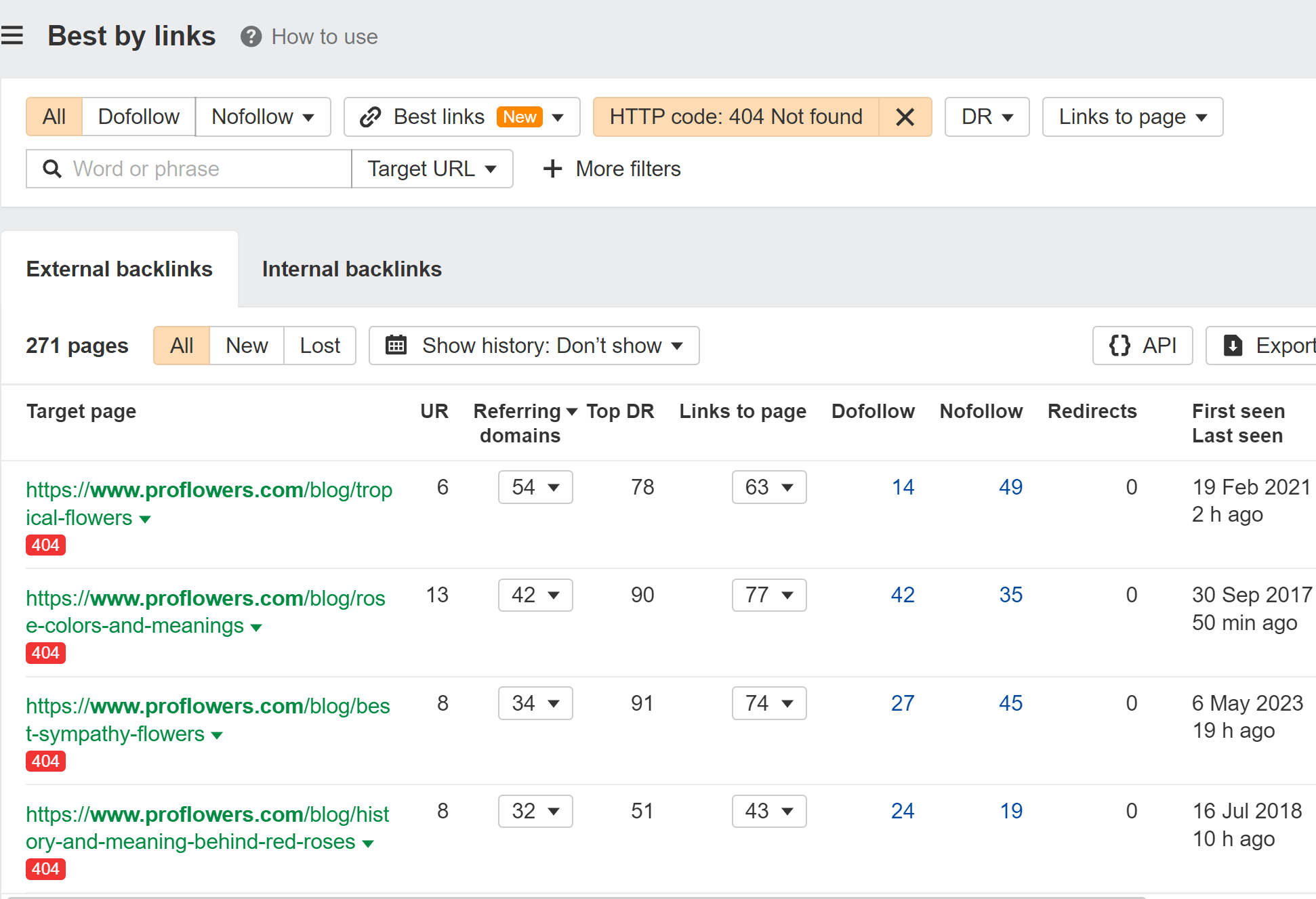
I even created a script to help you match redirects. Don’t be scared away; you just have to download a couple of files and upload them. The Colab notebook walks you through it and takes care of the heavy lifting for you.
While this script could be run periodically, if you’re constantly having to do redirects, I would recommend that you automate the implementation. You could pull data from the Ahrefs API and visits from your analytics into a system. Then create logic like >3 RDs, >5 hits in a month, etc. and flag these to be redirected, suggest redirects, or even automatically redirect them.
If you had redirects in place for a year or more already, the value is likely already consolidated to the new pages. That’s what Google recommends and seemed to be true when we tested it. You could also add a flag for “was redirected” into the automation logic that checks if the page was previously redirected for a year to account for this.
Copy competitor links and strategies
There are a few different ways to do this. The usual recommendation for SEOs would be a link intersect report, which we have, but it’s pretty noisy for large sites.
What I would recommend instead is the Best by links report in Site Explorer.
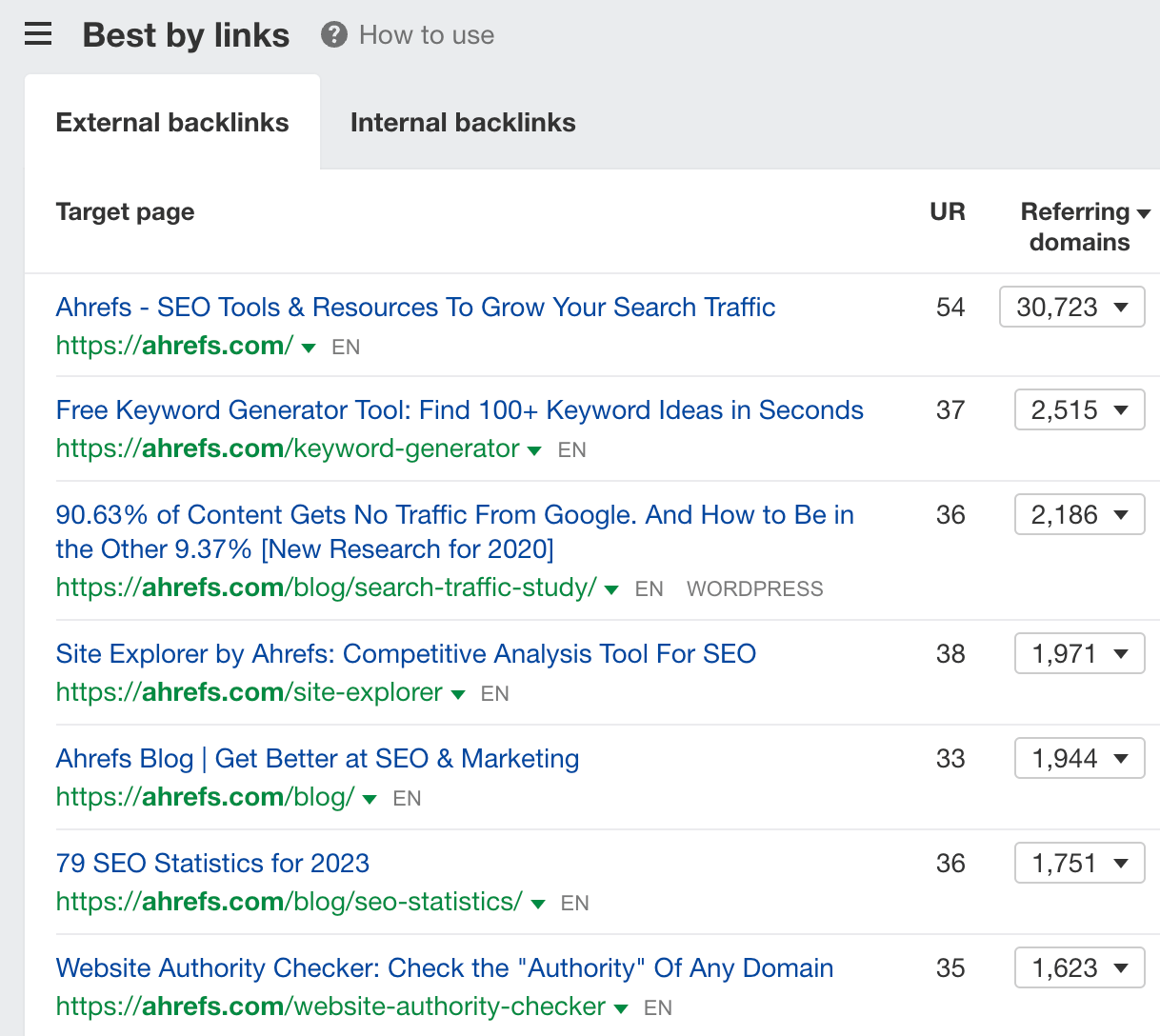
This is going to show you the most linked pages on a website. For us, that’s our homepage, some of our free tools, and our blog and data studies.
Another option is the Site Structure report in Site Explorer sorted by Referring domains or Referring pages.
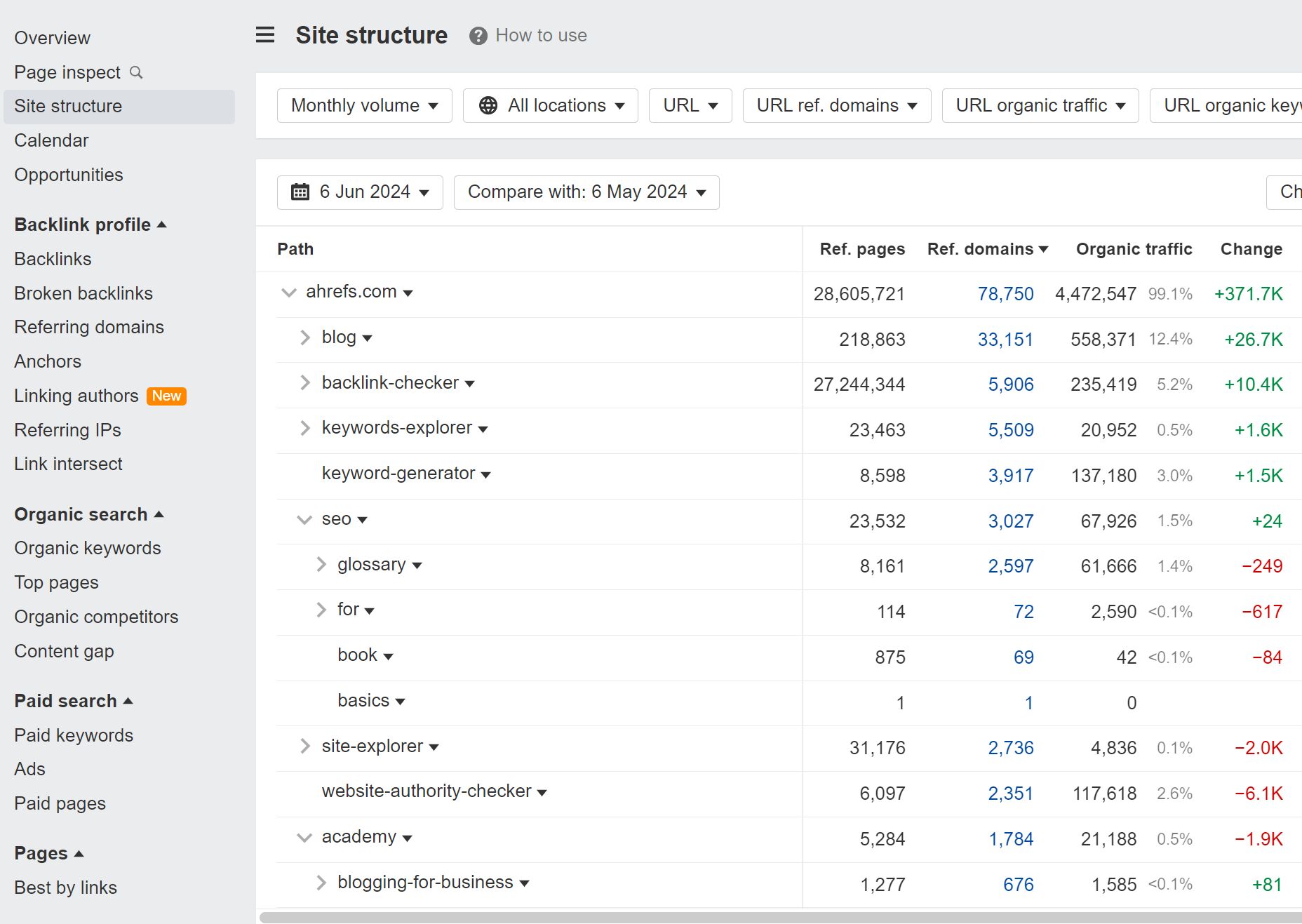
This lets me quickly see that things like our blog, free tools, glossary, and training academy videos are all well linked.
Build internal links
I’ve always found internal links to be a powerful way to help pages rank higher.
Even these links may be difficult to get in an enterprise environment. Sometimes different people are responsible for different sections of the website, which can make internal linking time-consuming and may require meetings and a lot of follow up to get internal linking done.
On top of the political hurdles, the process for internal linking can be a bit convoluted. You either have to know the site well and read through various pages looking for link opportunities, or you can follow a process that involves a lot of scraping and crawling to find opportunities.
At Ahrefs, we’ve made this simple, scalable and accessible so anyone can find these opportunities. The easiest way to see internal link opportunities is with the Internal Link Opportunities report in Site Audit. We look at what your pages are ranking for and suggest links from other pages on your site that talk about those things.

I’d also recommend watching out for opportunities to use better link anchor text. It’s common for page creators to overuse generic link anchor text such as ‘learn more,’ ‘read more,’ or ‘click here.’ You can look for usage of this kind of generic copy in the Internal anchors report in Site Explorer.
Build links from other websites you own
If your company owns multiple websites, you’ll want to add links between them where it makes sense. Ultimately you may want to consolidate the content into one site, but that’s not always feasible. Even if it is, it may not happen within a reasonable timeframe, so you may want to add links between the sites in the meantime.
This can be abused and goes into a gray area, but for the most part, if you’re linking naturally to relevant pages you’ll be fine.
Buy other companies websites
I wrote all about SEO for mergers and acquisitions. When you buy another company, you inherit their content and their links. This opens some nice options for consolidating content and links to stronger pages.
Ahrefs for enterprise technical SEO
[/post_nav_link]Enterprise sites can have complex infrastructures and a lot of legacy systems in place. There may even be many different teams responsible for maintaining everything, which means the technical environment and the political environment can be tricky. Sometimes pages or sections of the site will have issues that never get fixed because doing so is too expensive.
One mistake can keep millions of pages out of the index or remove an entire site from search results. There are so many moving parts, so much that can go wrong, and so many times that you’ll need to choose the least bad option.
You won’t have control of everything. Just do the best you can and when you have the opportunity, make the most future-proof decision you can.
When focusing on technical SEO projects, you’re likely to have an unlimited number of things fighting for your attention. You must learn how to prioritize tasks and focus on the most significant issues. While it would be great if you could get everything technically perfect, it’s simply not realistic. One of the things I like about Ahrefs’ Site Audit is that you can choose to ignore issues that you don’t find important.

In the world of enterprise SEO, you’re likely going to rely on many different teams to get work done. You’re going to have to be opportunistic and help many of these teams on their own timeline, when they are ready to go, but that doesn’t mean you can’t prepare for them ahead of time.
You’ll want to find out how these teams work, their processes and tools, and opportunities you may have to interact with them like scrum calls, team calls, or office hours you may be able to join. If you can be very clear in your communication with the team, it will make the process a lot easier. Learn to write tickets in their project management system that communicates the problem, expected outcomes, and the value of implementing the changes.
One final tip is that if you don’t seem to be making progress on projects, try to sell the changes you want to make as A/B testing. Many companies want to do more testing, and you can “test” your SEO changes to see the impact they have. With a measurable impact, you can argue for a more permanent fix, but in the meantime it’s technically fixed.
I wanted to cover some projects to help you get started with technical SEO in an enterprise. Of course you may want to start with a technical SEO audit first and check out our guide on enterprise technical SEO.
Check indexing
Priority - high
You probably have some pages indexed that shouldn’t be, and many pages noindexed that should be indexed. Canonicalization is another issue to check to make sure the version of a page you want indexed is the one that is indexed.
First, check the Indexability report in Site Audit for “Noindex page” warnings.
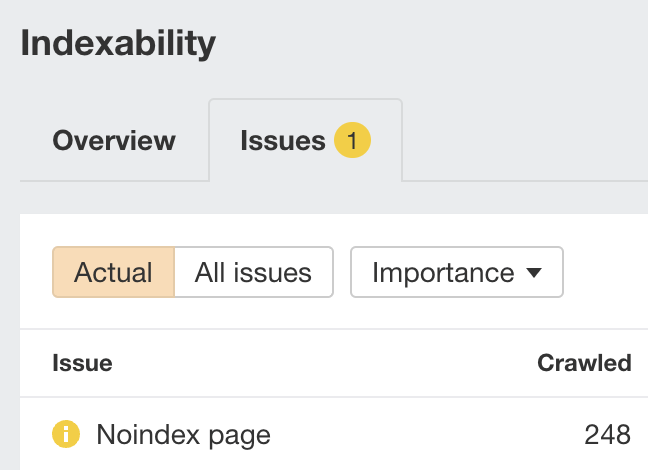
Google can’t index pages with this warning, so it’s worth checking they’re not pages you want indexed.
You can also check the Site Structure report in Site Explorer for any pages with organic traffic that shouldn’t have traffic.
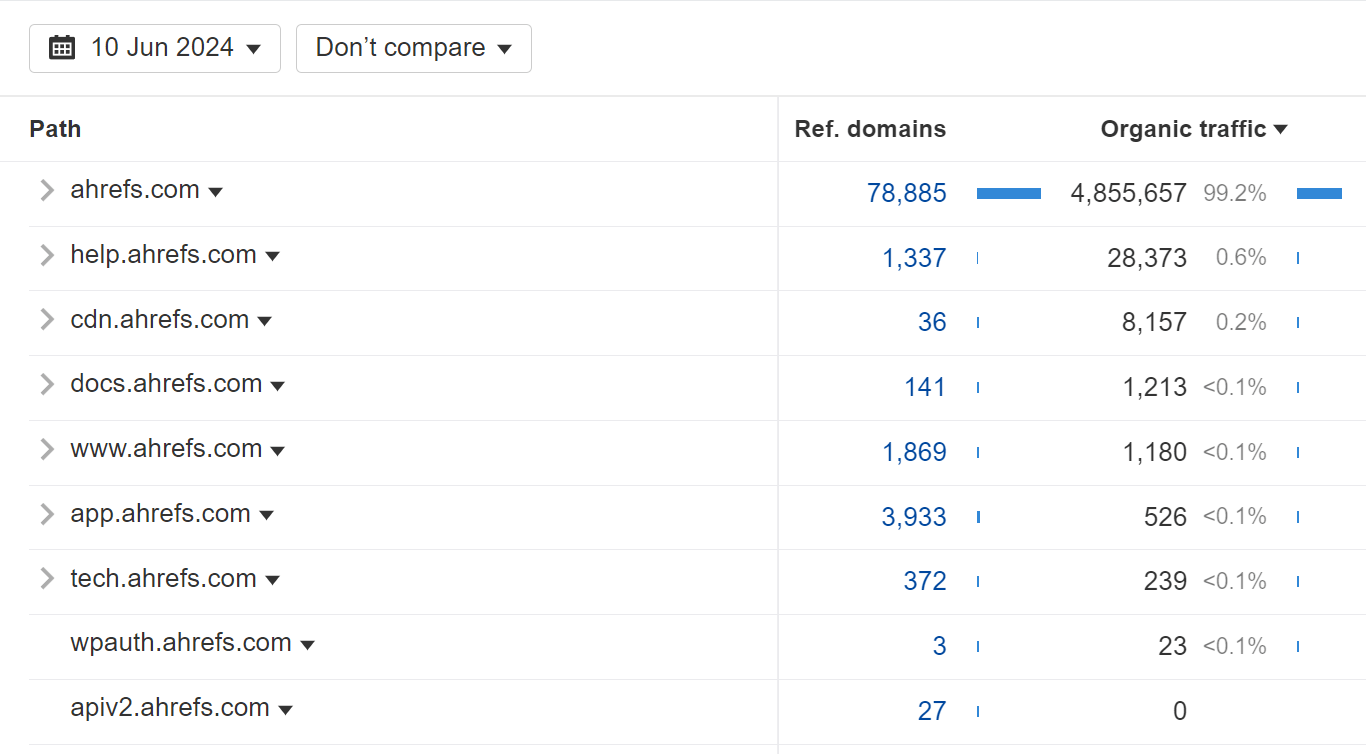
Recover links with link reclamation
Priority - high
Sites, and the web in general, are always changing. We ran a study that found that ~two-thirds of links to pages on the web disappeared in the nine-year period we looked at.
In many cases, your old URLs have links from other websites. If they’re not redirected to the current pages, then those links are lost and may no longer count for your pages.
It’s not too late to do these redirects, and you can quickly reclaim any lost value and help your content rank better. I normally assign a dollar amount like $400 per referring domain in order to make a business case for this.
Here’s how to find those opportunities:
- Paste your domain into Site Explorer
- Go to the Best by links report
- Add a “404 not found” HTTP response filter
I usually sort this by “Referring domains.”
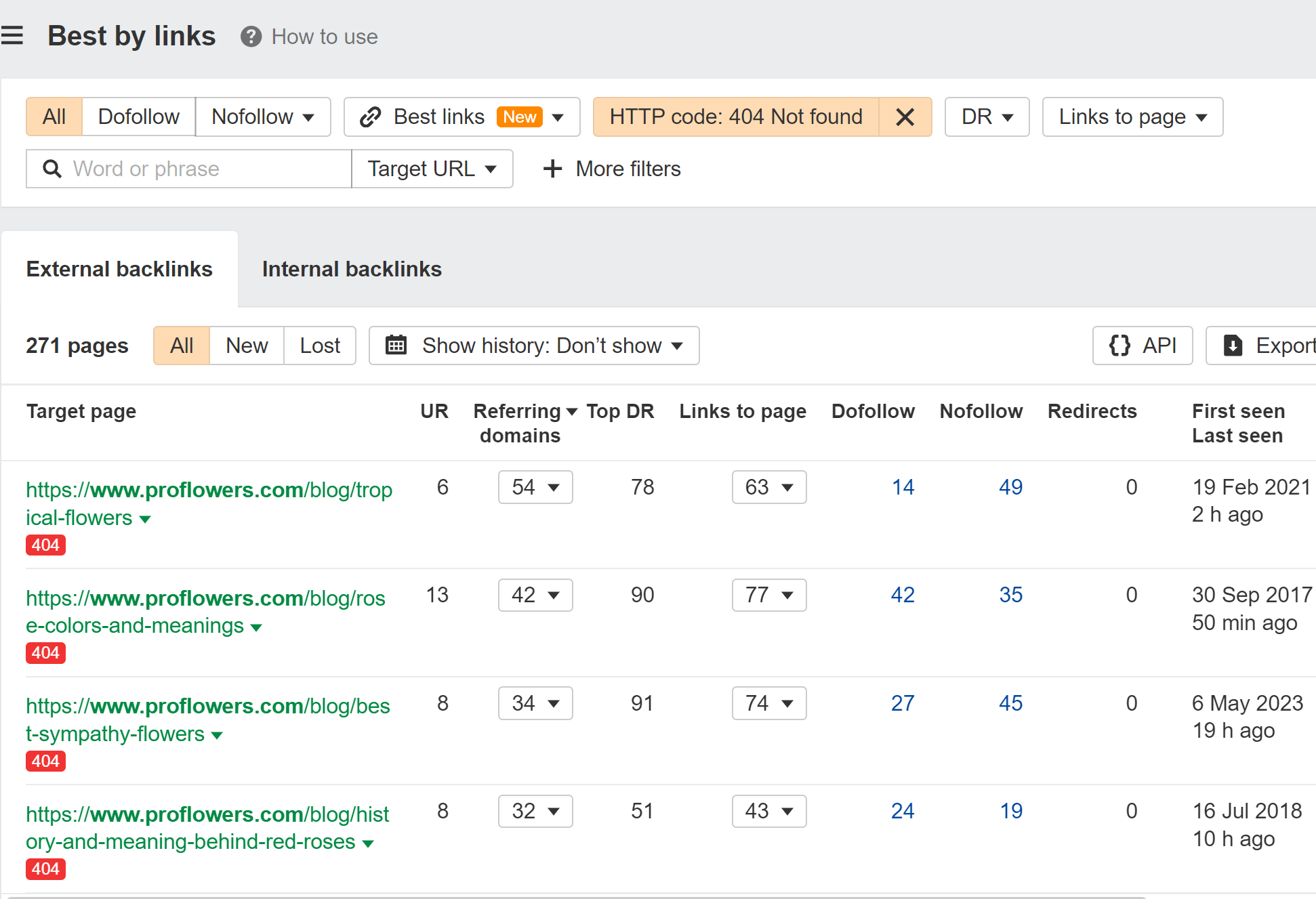
I even created a script to help you match redirects. Don’t be scared away; you just have to download a couple of files and upload them. The Colab notebook walks you through it and takes care of the heavy lifting for you.
While this script could be run periodically, if you’re constantly having to do redirects, I would recommend that you automate the implementation. You could pull data from the Ahrefs API and visits from your analytics into a system. Then create logic like >3 RDs, >5 hits in a month, etc. and flag these to be redirected, suggest redirects, or even automatically redirect them.
If you had redirects in place for a year or more already, the value is likely already consolidated to the new pages. That’s what Google recommends and seemed to be true when we tested it. You could also add a flag for “was redirected” into the automation logic that checks if the page was previously redirected for a year to account for this.
Add internal links
Priority - high
I’ve always found internal links to be a powerful way to help pages rank higher.
Even these links may be difficult to get in an enterprise environment. Sometimes different people are responsible for different sections of the website, which can make internal linking time-consuming and may require meetings and a lot of follow up to get internal linking done.
On top of the political hurdles, the process for internal linking can be a bit convoluted. You either have to know the site well and read through various pages looking for link opportunities, or you can follow a process that involves a lot of scraping and crawling to find opportunities.
At Ahrefs, we’ve made this simple, scalable and accessible so anyone can find these opportunities. The easiest way to see internal link opportunities is with the Internal Link Opportunities report in Site Audit. We look at what your pages are ranking for and suggest links from other pages on your site that talk about those things.

Add schema markup
Priority - high
I’m a fan of schema markup as long as it gets you a search feature. Check out our guide to schema markup to see which ones you should be implementing. There are some cool tools now that can even suggest schema markup based on what is seen on the page.
Fix Page Experience
Priority - medium
While many of these aren’t necessarily going to move the needle for SEO, they are good for users and how they experience your website, so they’re worth working on.
- Core web vitals. This is how fast your pages load.
- HTTPS. You want your pages to be secure. A surprising number of sites, >6%, redirect HTTPS to HTTP.
- Mobile-friendliness. Are your pages usable on mobile?
- Interstitials. You don’t want intrusive interstitials, or those that take up a good chunk of the screen.
We cover most of these in Site Audit. For example, we pull PageSpeed Insights data so you get actual Chrome User Experience Report (CrUX) metrics for Core Web Vitals as well as Lighthouse metrics in Site Audit.

We also flag mobile SEO issues.
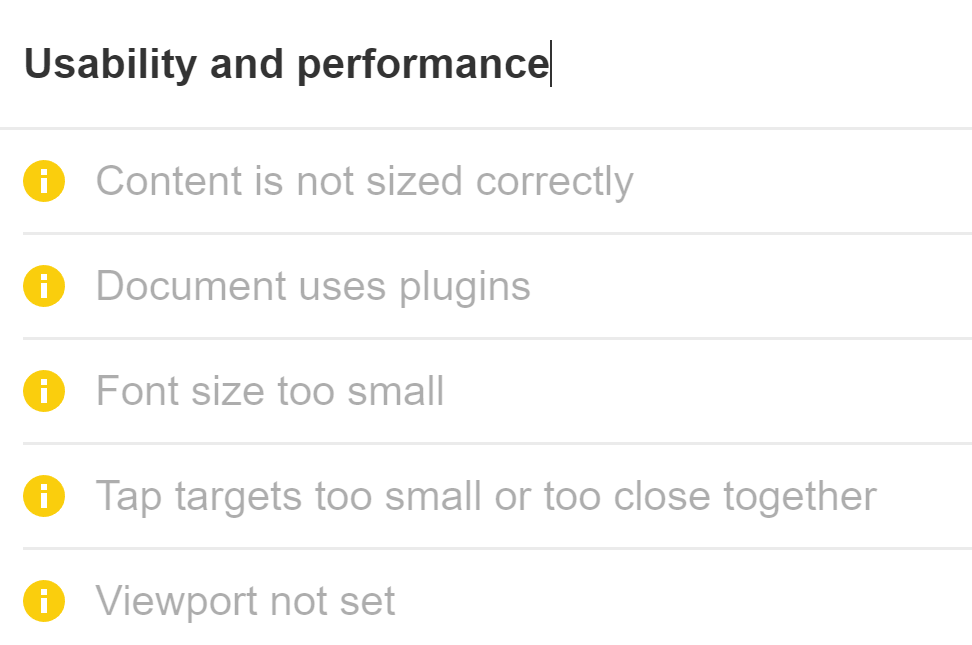
General website health / maintenance
Priority - low
These may not have much impact on SEO, but can be an important consideration for user experience.
- Broken links. Find them and fix them.
- Redirect Chains. Google will follow up to 10 hops. I don’t worry until after 5 hops.
- Add sitemaps. I would make sure this is automated. If you are asked to manually create them, you can do it, but just know that if it’s manual these will rarely be kept up-to-date. If you’re creating them based on crawled pages, then it’s likely all search engines can crawl them anyway.
You may want to check if any of the chains are too long. Look for this in the “Issues” tab in the Redirects report.

Fix Hreflang issues
Priority depends on the site
Hreflang helps show the right page to the right user in search. This can be crucial for enterprise companies to get right as the dropoff from bad pathing or annoying users can cost you a lot of money.
We flag a number of different hreflang issues in Site Audit.
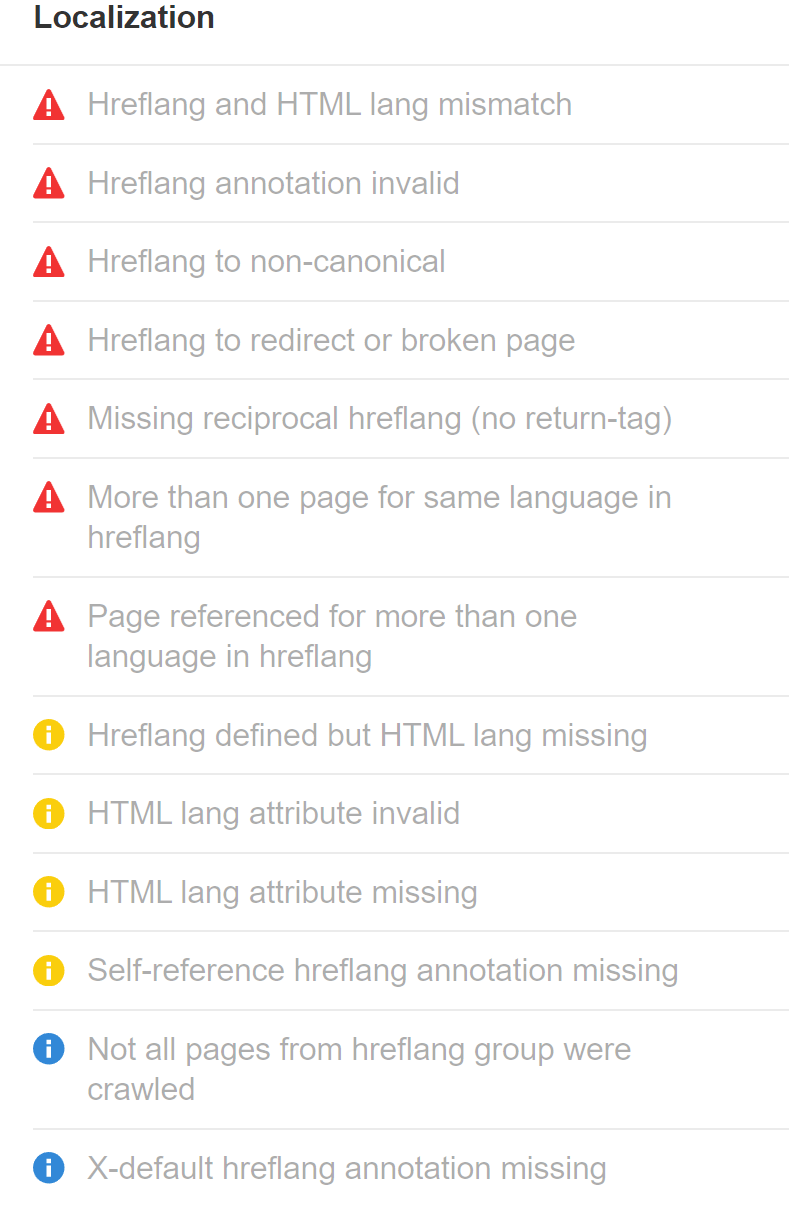
There are also some nice visualizations to help you explain issues like this first-if-its-kind hreflang cluster visualization. It shows and tells you what is broken, making it much easier to explain to stakeholders than the typical spreadsheet.
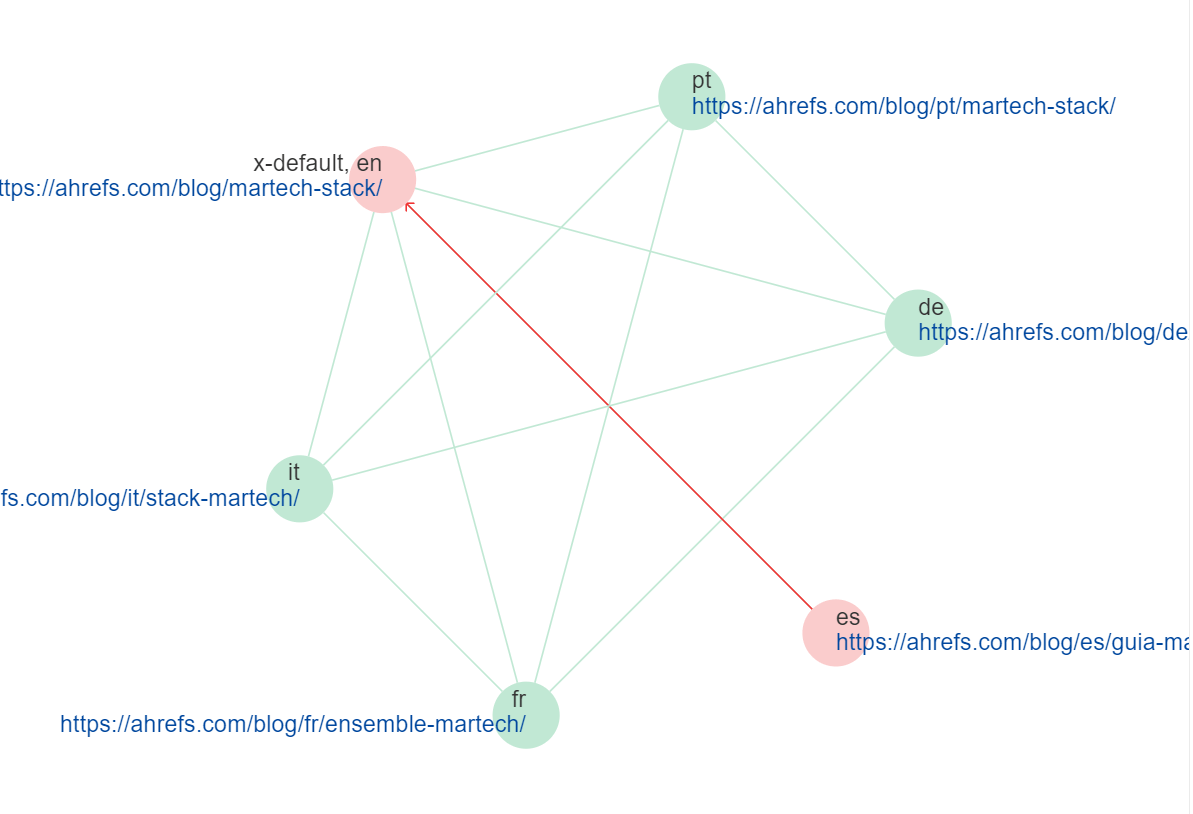
Optimize crawl budget
Priority depends on the site
Crawl budget can be a concern for larger sites with millions of pages or sites that are frequently updated. In general, if you have lots of pages not being crawled or updated as often as you’d like, then you may want to look into speeding up crawling.
Optimize ecommerce pages
Specialized task
Ecommerce SEO would be important for any sites selling products.
For enterprise sites, faceted navigation in particular can be tricky. Luckily we have a great guide on faceted navigation.
Fix JavaScript SEO issues
Specialized task
The bigger the site, the more likely you are to run into multiple tech stacks. Some of those may be JavaScript frameworks. These are relatively newer than CMSs and less understood by SEOs, so we have a guide on JavaScript SEO that covers many of the issues you’ll face and how to troubleshoot them, as well as how the rendering process works for Google.
Migrate other websites
Specialized task
A website migration is any significant change to a website’s domain, URLs, hosting, platform, or design. Big companies like to change these things and it creates havoc. Try to write any standards to keep things consistent and minimize the impact of changes.
Keep traffic during mergers and acquisitions
Specialized task
Enterprise companies buy other companies all the time. When I worked in enterprise SEO, I felt like I was constantly doing one website merger project or another. There’s a lot that can go wrong and a lot of money on the line. Check out our guide on SEO for mergers and acquisitions for more info.
Onboarding an enterprise SEO tool can be a long and difficult process. Getting rid of a bad tool once it’s integrated into your systems can be even harder. Make sure you do your homework and select the right solution for you.
As we’ve built out our enterprise offering, we’ve added a lot of features that enterprise companies need to be successful and all the pieces they need to meet compliance guidelines. If you have a feature you want to see us add, message me on Twitter.
